Chapter 1. Chapter 11: Single-Gene Inheritance and Meiosis
1.1 Introduction

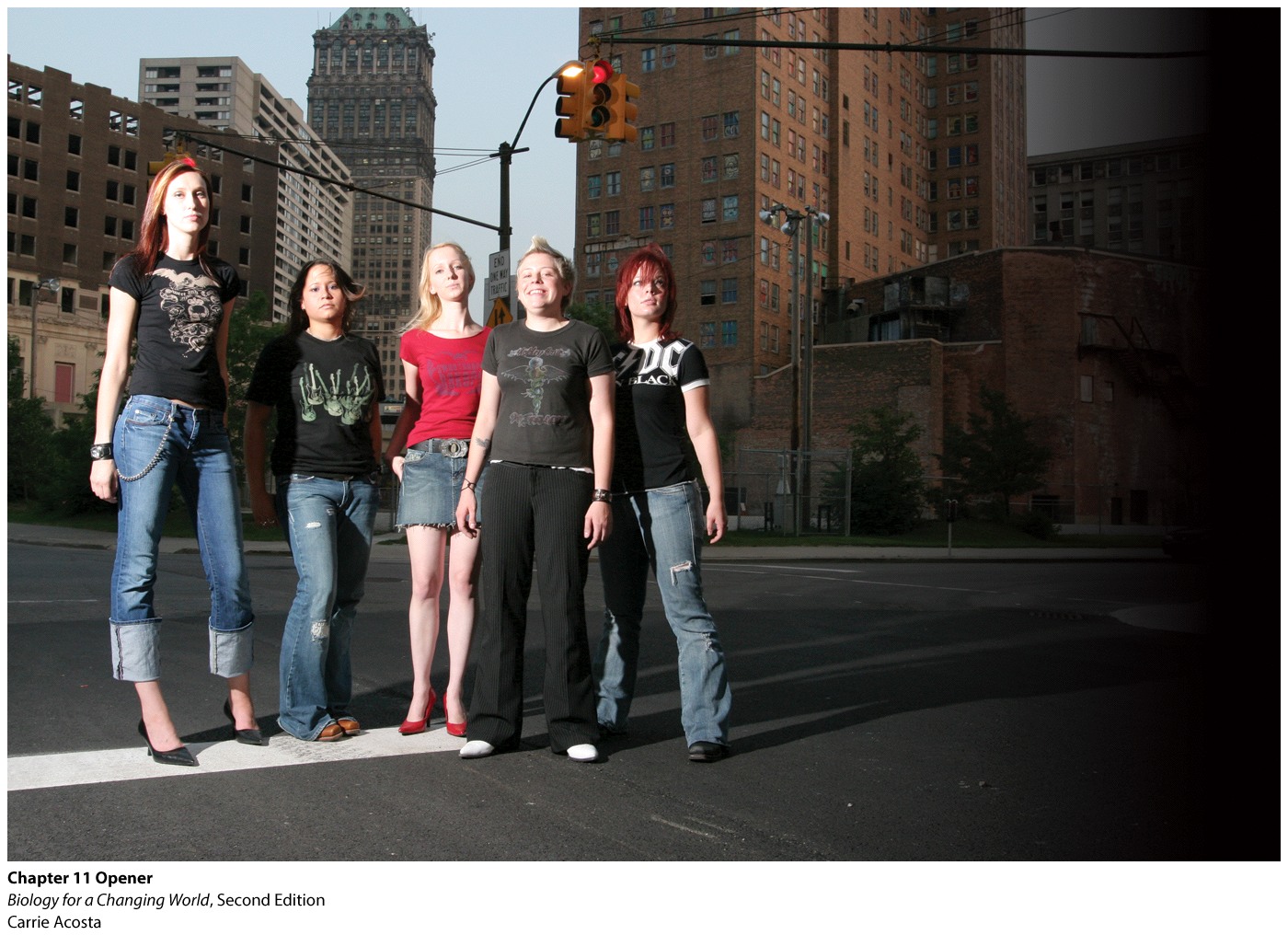
Welcome to the Interactive Study Guide for Chapter 11: Single-Gene Inheritance and Meiosis! This Study Guide will help you master your understanding of the chapter's Driving Questions, using interactive Infographics and activities, as well as targeted assessment questions. Click "Next" to get started, or select a Driving Question from the drop-down menu to the right.
Rock for a Cause:
From patient to performer, shining the spotlight on a genetic disease
DRIVING QUESTIONS
- How does the organization of chromosomes, genes, and their alleles contribute to human traits?
- How does meiosis produce gametes?
- Why do different traits have different inheritance patterns?
- What are some practical applications of understanding the genetic basis of human disease?
1.2 Driving Question 1:
Driving Question 1
How does the organization of chromosomes, genes, and their alleles contribute to human traits?
Why should you care?
Cystic fibrosis (CF) is just one of many genetic diseases caused by mutations on single genes. Understanding the chain of events from to protein malfunction to disease will help demystify genetic disorders in general. Furthermore, studying the relationships that exist among genes, chromosomes, and inheritance will help you understand the inheritance of traits in general.
Emily Schaller inherited CF from her parents, who had no idea they carried the disease. There is a 50% chance that each of her brothers, who do not have CF, are also carriers of the disease and could potentially pass the gene on to their future children. Understanding how genes are passed on and inherited is essential to making informed decisions about planning a family.
Since both her parents are carriers of the mutation, Emily Schaller has CF because she had a 25% chance that the egg and sperm that united to create her happened to each contain a copy of the mutated CFTR gene.
What should you know?
To fully answer this Driving Question, you should be able to:
- Differentiate between chromosomes, genes, alleles, and proteins.
- Describe and diagram the changes that occur to the CFTR gene sequence in one of the possible mutations leading to CF.
- Explain why changes in the amino acid sequence of a protein can change the functioning of that protein, or even make it nonfunctional.
- Identify the number of chromosomes in human nonreproductive body cells.
- Explain why almost all human chromosomes exist in homologous pairs and how they are inherited.
Infographic Focus:
The infographics most pertinent to the Driving Question are 11.1, 11.2, and 11.3.
Question Test Your Vocabulary
Choose the correct term for each of the following definitions:
| Term | Definition |
|---|---|
| 06uSz9fMIfw80C7ZDJt+NvcE9v696dJGU/AfLkzkXGdwLgqOInrM8LeoSgeG6GXFaqhNadTtzZ/51xxNRAML9Q== | The visible or measureable features of an individual. |
| OBJ1MaZ6FjbTSVll6R9Aksk3lzFmaPW198VT8U+eiEXg+Cs32bWvA7K/4zpLcs26RYF5QP82vDYL0il6fzJ95g== | A pair of chromosomes that both contain the same genes. In a diploid cell, one chromosome in the pair is inherited from the mother, the other from the father. |
| /BX9saGrsLsL7tbyjqE7irpqATExxrj/Rwe6xtS5WfYTStj9RkWSHVbUqunomo3D7U7j/M9zS5vpz3vOlr9ICg== | A change in the nucleotide sequence of DNA. |
| 3qdfHNNVB5dR7IodupBEeaCqvk/aa5gGGamyemK3m98hZTvaJI273+l8iWHU+JPbqh/G3zZKRcJlCpD6cSTl5w== | The particular genetic makeup of an individual. |
| kz0yN8D1Wtx2Ep0XFBoCtpoqXhbJsQPyRkMMBVNuXuB/HMxwRE8Dd3ap4H7TyQq2DiK9e6Uxj/FBaRms39kwNA== | Having two copies of every chromosome. |
Differentiate between chromosomes, genes, alleles, and proteins.
Question 1.1
Match the following terms to the definitions:
| 0cp5aOQrxjVYTL0MF5/N9nCo8oUVPdv7yOE/Zg/6ZN03piN4 | A single, long DNA molecule (wrapped around special proteins) that contains the individual instructions for many different proteins. |
| 3LYuzheIvK+7qE23i7s+9tJhfdkS5AUSRKzWrzXKSxd6kqhE | An alternate version of a gene. |
| BUZmhjd+pXmiZS5R1n6vmUAUUuek5e1mLlUF3MzXhqG/gmUo | One or more chains of amino acids connected in a specific order and taking on a particular shape that is functional. |
| 2PYEIeeJAExgcZjRByRwhpXaylsHN2YKkTy2kb+Wsq3z4ict | A section of DNA that may contain the instructions for assembling amino acids together into a polypeptide chain. There may be several alternate versions of the instructions. |
Describe and diagram the changes that occur to the CFTR gene sequence in one of the possible mutations leading to CF.
Question 1.2
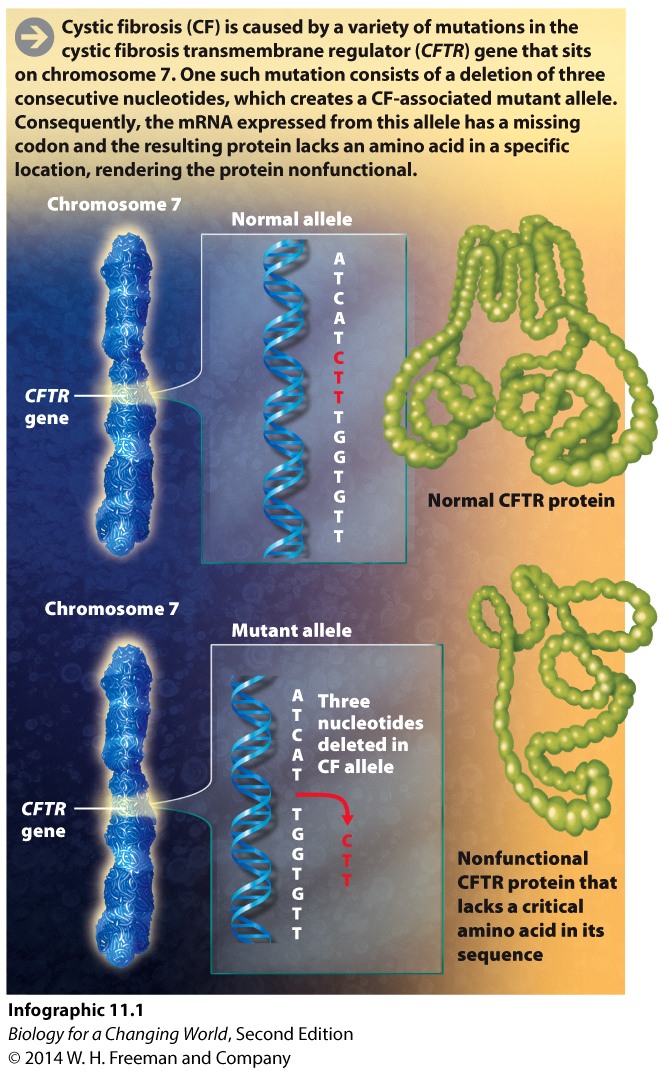
Mutant gene: ATC ATC TTT GGT GTT
Normal protein Ile – Ile – Phe – Gly – Val
Mutant protein Ile – Ile – Gly – Val
Phenylalanine is missing from the mutant CFTR protein.
Explain why changes in the amino acid sequence of a protein can change the functioning of that protein, or even make it nonfunctional.
Question 1.3

Identify the number of chromosomes in human nonreproductive body cells.
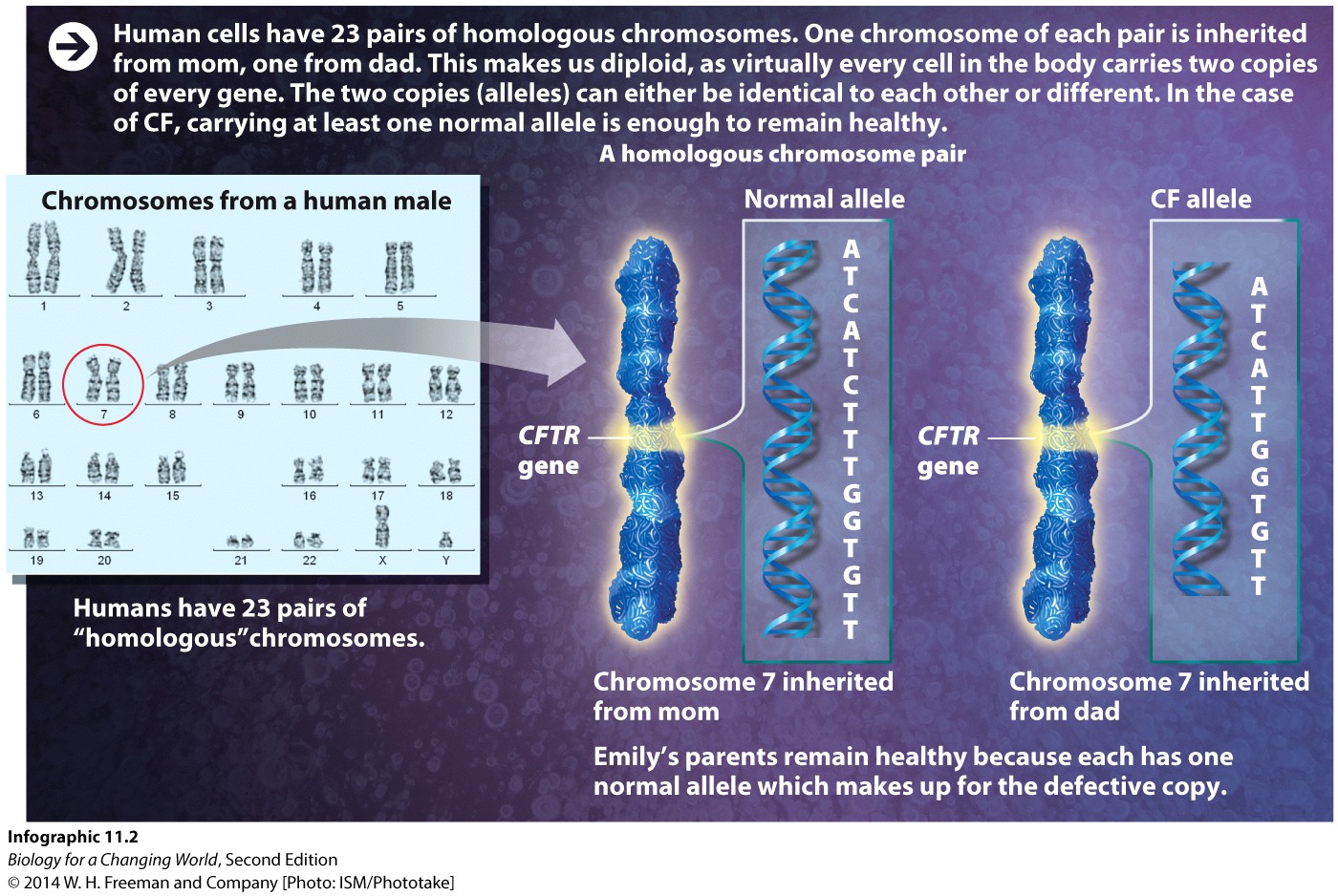
The left panel of Infographic 11.2 shows a human male karyotype—an ordered display of the metaphase chromosomes (i.e., each consisting of two sister chromatids) found in a non-reproductive, body cell from a male human.
Question 1.4
Count the total number of chromosomes in this karyotype.
How many total chromosomes are there? iyFLvrSsjIE= chromosomes.
How many homologous pairs are there? HOObzUzdvKo= pairs.
Question 1.5
Vvbs9fbH7LJYtvufqmZbthIw2PxNZK+uyOZNYaiX4W1AIT9/+NTmJoqi/2+nIvfO/QhnwYv8raiZhKr/EEE1sODZ6/4AaYB/TUdIIEq9cd5g/cFrw3GFRK2HNvalblHHa//nD85STB8nkcSbYuMR1nzmgM94NN6o5rFFHg==Explain why almost all human chromosomes exist in homologous pairs and how they are inherited.
Question 1.6
kfaniyDzHCvZZSp9qLW4RzKWdAzuhPOVC3zOVQbh/gUWUM5DjKijbAuvxHIJjwBu45wKR1ETb0MY1pPJzuGvT0EH9Ewp4IkFiu7Nl5ltWn202Oxj4ObmpB9xDcH+rHccHhdnsr0LTtmOjMMrJH3Uk1YBPpr+jjqONWpZs+NIwmI=Question 1.7
i/XdDUxDwPeOP1WcWXWJtZXS1mKT6WNmtzwq3DN5G+6Bl9HEAJDSbSb+qYQDlY5FnD1pfgMvvo55bU484A2pFAOdMF6MI0NowTTose214p3rkacbF2dLaCkENoMrLF7kQuestion 1.8
hpj5/8gJxtTG0fnsP8ZCXuvMID4p08cwCr0dby2UHiDSQxA7N21H2u11bneXi4DAmB2goMV8eqI=Question 1.9
lmFlWhhVkMx8Ri3KC3EB+g5jUWF2losVjoe3dajBShvMN7qpcL3l/WkQMHg8pBS/q2/vQWr+TCWEQ7ZNn1fiqzZiZPaN8PqVwvmJ6A==Question 1.10
cQhIVL18icSz59z2ASkqTaXoS8Yb5F4EwQjgqCCKbLo5nlFZPytMZ5jf9acqPtbCFIng02eWbyGkhvTAebVBu7yt9/B6BkMVCobKtaYGrK6DKuYuY7KNhaE8gTSnnSYWlivHqWuZf2WSfTr/+aoM2Q==Review Questions
Question 1.11
6QiX/ifNTwdfeIS6tWWQ4PWkPUGnyinj9xA38JawTqngtTFB1v8Pg8VCsvZaj5lxRD3E7rDqyz5kH6KcBSXGG7Ev8Js0OLgLG5C6y9uiCtonDcmP6C1aP7Ri+op/0zmQMZq912Ij7LnoM31T4XTQPwR4D8nxG/3B5qpzP4SBenQ3LaPQVLqpKgSE8sE+dBOkJCbjiS42wYzzfuSXM9lEoohyrUJO7LWQ8+QtTHgWVV69CY9MXLqWHEIwXcPGLGAtMuXAvil9vPpP1s/f4KDXn6OHTFGLG2kwwWtOaZ4tgdejQjcW9k+ljVOCconGPbDkQcu0IBoDCIHbEaxqhTouhyvMCeOTr+CLrRlkaEs+eeuSPCgsIcxvtgf7QfZZF3eT4Gr0Da4fwQi9vqwn6EYGY2rhTaN/Fcc3doSkc7ex97zTvnjSqRMfmGmWQYgo8YO5Sbv1noP99KlJJxqnXDMd1JxU2Tu1VAgryr+pk87+kg+LpfrnybUlh2OkzXVi4M3VMQm+0EIUGaxq0DBR72ffsRKZxbhNuWg4mBH9Ow==Question 1.12
AznfgbvakY1+TlzZmz6E+nPYGewDBxVYSo7AGaEUYr7tBUq0J4Z+KUvSgh0E7GN2YzUUatOXZHnGd6iVM1v8zTca0Jg2IFWKV0r+XpP4dQ/LJuHr5uKvXeQNPFSbIMss39xFYwOfdaBBFjPzAsjFxSLXoYIJca9TjG2+VLxFBvCF7xgOGpxKIVxSNrK4y81640cHeDf7c/wh/KEi0WfYxXZC/Tp5xEK0Question 1.13
Which characteristics can differ between a gene and its mutated allele? Mark "yes" for all that apply.
| a. Nucleotides | uS+xJY+rPntALoOB |
| b. Amino acids | uS+xJY+rPntALoOB |
| c. Shape | uS+xJY+rPntALoOB |
| d. Length | uS+xJY+rPntALoOB |
1.3 Driving Question 2:
Driving Question 2
How does meiosis produce gametes?
Why should you care?
If you are a fertile man, at least some of your cells are undergoing meiosis nearly continuously; if you are a fertile woman, at least one of your cells will begin the process of meiosis every month or so. Meiosis is essential for producing gametes with the proper number of chromosomes. Some genetic disorders result from errors in the inheritance of whole chromosomes, rather than individual genes; those errors usually result from mistakes occurring during meiosis. Understanding meiosis will help make sense of the rest of human inheritance.
There were many chance events leading up to the union of gametes that created Emily Schaller. There was chance behind which egg and which sperm cell united. There were chance events behind every chromosome that she inherited from her mother and father since chromosomes assort independently during meiosis. There were chance events involved with the specific alleles of the genes that were on those chromosomes since recombination occurs during meiosis. All of these chance events lead to the creation of Emily and are also why siblings (excluding identifcal twins) are not only different from one another, but also different from their parents.
What should you know?
To fully answer this Driving Question, you should be able to:
- Explain how meiosis halves the number of chromosomes.
- Explain how independent assortment of chromosomes contributes to the variation in the combination of chromosomes, genes, and alleles a child receives from their parents.
- Explain how recombination of sections of chromosomes contributes to the variation in the combination of chromosomes, genes, and alleles a child receives from their parents.
- Compare and contrast meiosis I and meiosis II.
Infographic Focus:
The infographics most pertinent to the Driving Question are 11.3, 11.4, and 11.5.
Question Test Your Vocabulary
Choose the correct term for each of the following definitions:
| Term | Definition |
|---|---|
| mYLIC2F5v3ZyAc1RhZ+ix1O2UeMi5i42mFXlqDVvdoK8SlzJGYtFxEG92sbs5vf/NiO3Xw75fIFh6rA2AqdNXZLOHsXYRY9nmclRVz377yU= | Having only one copy of every chromosome. |
| 4/Vj7Viyak0pEP98NNEj+FFWzT0hV60THel3VA+hsA1zd3mupqijcSrqdl6BMZi6azIMANT0unr3KzSF2pdrf2GJkytttY2IeTV3sgY64uk= | The principle that alleles of different genes are distributed independently of one another during meiosis. |
| Kd5PLiqZXXrJDKHyHsX+NyBKOyzcxC0iddZ12J0ozyoSD4CsoTSi70yRbFwY7YldzExDpfGElZyu4uTaGQpyL8fSt4s65cBESscSPVrP4TI= | An early stage of development reached when a zygote undergoes cell division to form a multicellular structure. |
| A2Siu1AnPNtUiBuDBubVivdo4PmjqWYH/W4o1pBk/aieyNtEC9TIno8oXwRANQLD7uz5TFNc/VspRC+7O5AQ1A9b9WbjV2Cdz+NSnX6h7Vk= | An event in meiosis during which maternal and paternal chromosomes pair and physically exchange DNA segments. |
| Naq41sDhYPFjxLqBA0/q5SlvlId0try0F2efiIrwQ8+b9hPCb67kydr8YmME24Do1eIc9k+REvmGLbzJHsn1Mft6MCcg+bHoJIe2GNOO1e4= | A cell that is capable of developing into an adult organism. The zygote is formed when an egg is fertilized by a sperm. |
| 7Lhz1b10pSgwfZT984d8yhVFzR8DfMQSTCUKQ9sZeMmml/FqUs1xX8alfLScyY26ZZbvrGsT9eY7wbiRbVG098i5xaQ0kQVqGw4dc/+V668= | Specialized reproductive cells that carry one copy of each chromosome (that is, they are haploid). Sperm are male gametes; eggs are female gametes. |
| m2+8LYQF5oAe1/eKBWmnXsXO8K9IKLkXxdxQLHhPUcUlf0SyKPPH2x0wUsR5Zw2vcY30dvqH3e8SZpvjdGXeWPrYGkbOZ5OYnMAvLXNinNw= | A specialized type of nuclear division that generates genetically unique haploid gametes. |
Explain how meiosis halves the number of chromosomes.
The diagram below depicts the process of haploid egg and sperm formation through meiosis of a diploid cell, for an organism with a diploid genome of 4 chromosomes (for reference, humans have a diploid genome of 46 chromosomes).
For now, we will ignore the processes of recombination and independent assortment.
Each numbered element on the diagram (1 - 7) corresponds with a numbered instruction or question (listed below). Follow the instructions and answer the questions to complete the diagram.
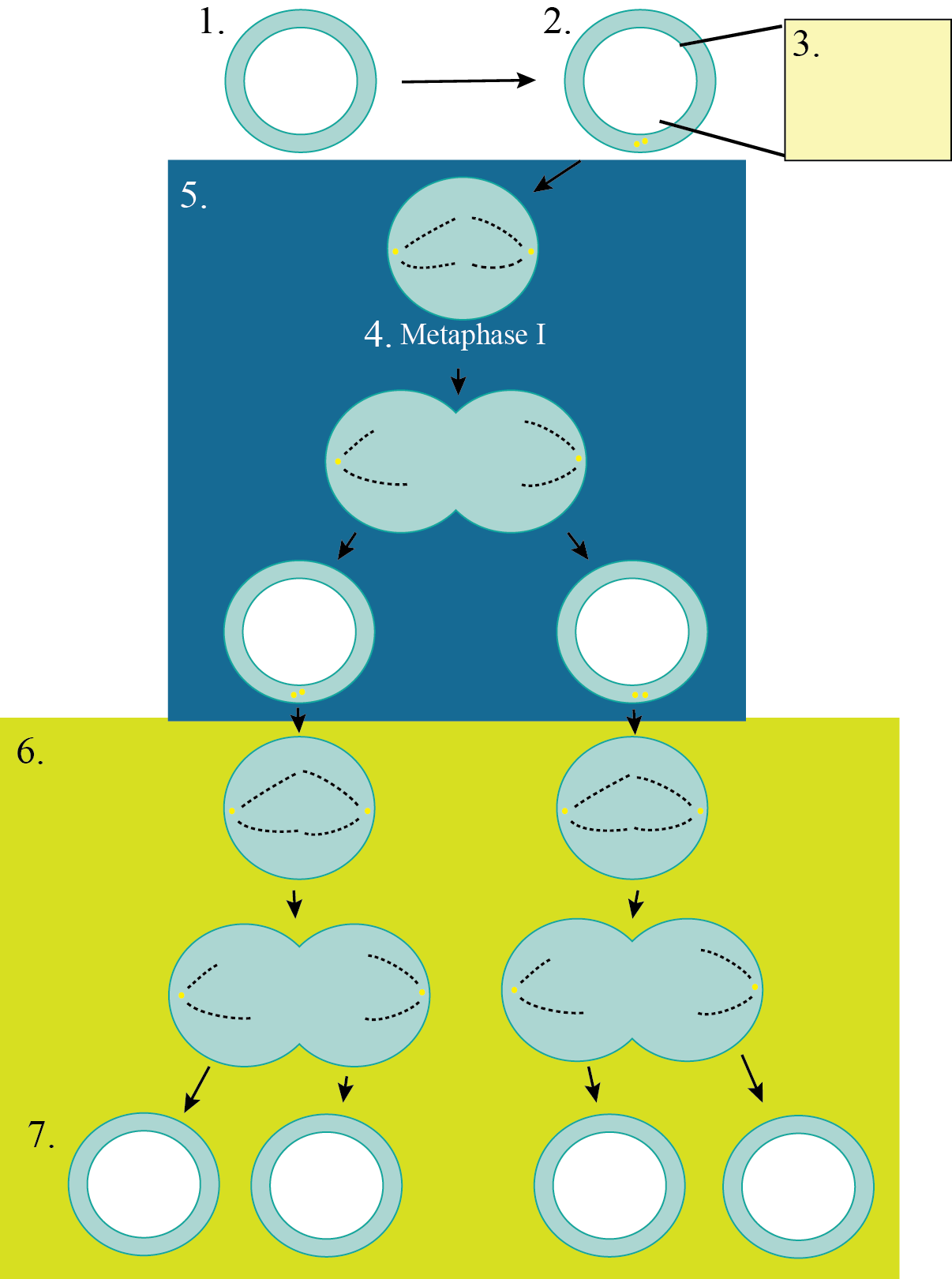
Question 1.14
1: In your notebook, draw the chromosomes of the starting diploid cell from this organism.
hpP1xYkzBR2FSutDlIh/fGLojMjYOSKlQDuGV5Z7EN+mlsC13cmaK65HgemdyNcVsuwKMHQV6ruUnY1u0j4h+Wc+Ld+xBzsvhjLjDA9whl3bejYXKbhoKKC0htELTpN8q/K19emV+7UPy4f8WG3YmPaBWPcCOv2Z3t2O41OIQMx1LzG81fz1k8us0ZgatgGim/fU8D7lwLI2YhGjO/WqvuJBPRo= xsPxb46T2G0HRwwtrRnIAMpOzN73mJD2GxzleVlAma8cWsidRVi/H/uEwU7i74+Fmyrs0graLGXyuz0QBExOFZYzux2CS2XJbZx3Ft3CwtO7ub7tPa4rlpwlA/JBtSdbTIoD4trtnzd0uCmz6IQ6114c077/GPnnQuestion 1.15
2: Draw the chromosomes of the cell right before it enters meiosis.
Oxy/YocsuFZCSXobDHhkRn2t6kg2Oqx95kgpiOPHS1ML33BM8DpVKxpiTz4=Question 1.16
3: Draw one of the homologous chromosome pairs from the cell you drew in #2 and label the sister chromatids and the centromere for one member of the chromosome pair.
Edw6Hw4pYdpJvgTRggS2kzBaTT7bAIOWsbb1LUpYuAfrJ2zRMncn/7He+BIkn1mg5cf5o/3wW/9ZD9S3odJUCFtJmzqfxUJnK7Yrpg1EJnU=Question 1.17
4: Draw the homologous chromosomes during metaphase I.
4wE6hubOwq785sQPoXsIuFmSOkikYyBrj276ZiBnA1dqpBvbp5iwNpzoWIFvTC6zVKIiMMyOnIwYkJGInVV+Cl+1T0QeyOOeiTnnE7CjlHe7y+ufv/GQR56wuAY=Question 1.18
BLow97nmpHhV70YvWTl8eISwa2bsXvMrWWRT1pfgmBZ/fu4qJfGa8buXM76eYQToel2wkQWOMqd4W5GO+jBD0n5AjHfcaqsCQtFiZOs1cFuQq9HPnQz7uw== elW6Otv7fVnZLV23Myaxtm2V3XG00PDegLjpCfdkgdE2f7mNwiILoeLBL2vmDEZHAxDcQaVikjksF+cInoEpQ5QRs6TCl8wKRmEZ+1dkq54= N22WaXiGR/XweY1W5rZEpI3yQl5Ta5OYX1ZLGaCuyYTCkWKoiXSSL1TjzHeoselb9BmjTuY2qjs9/J4zVEWbiKM4OWqAjwt8p0A2apHrYJg341w6KLZCeFtgTtHHPhvFl5lQ55S/P0ggKDiBbr5BW/DyiMKc/4li20XL+w==Question 1.19
dfLjNinSiaouycITlmDn+tf+F8agUulLeu7y6lCIICvzPITkoqS/DQmG2uPKu95mWGWILTUBKMJwk4OykkcSC3aevc/Bw2/OzfH2m2h/PW68UXpsUa9mSvrDkIg= elW6Otv7fVnZLV23Myaxtm2V3XG00PDegLjpCfdkgdE2f7mNwiILoeLBL2vmDEZHAxDcQaVikjksF+cInoEpQ5QRs6TCl8wKRmEZ+1dkq54=Question 1.20
7: Look at the resulting chromosomes for each daughter cell after this second division.
DGoDuLGuAoCZyLKncMckJxocD8n6bYPxQAAqJRIVA7jIta8JhqDYEuE8SfUNx1xopLqCMTJFpttuWp75NJrB7AWpImpdMx9osGK05HniJAclT5QIcXvNZP9r+YXhZi9Pj7syIsnZs9D5q+R3sDx9WDB4E9w= Jv8hToxWYwh3BH6XasQcMyeint5kTXOlRA/Is7UpQDOl+IbbxhydFK7mMg1VFsSOtvF8EVg/nbiU2wslzn+E1R9FugsIbIU3sY5BnjFUSa7WhWaiJyBwZ+wDKVHz+oSeWpcbElGQxr4=-The daughter cells in Question 6 had two chromosomes that consisted of two sister chromatids each. In Question 8, the cells only have two chromosomes consisting of only one sister chromatid each.
-In Question 1, the cell had two pairs of chromosomes (for a total of four chromosomes), with one chromosome from each pair coming from the father and the other chromosome from each pair coming from the mother. In Question 8, the cell has two chromosomes (for a total of two chromosomes) that are not in pairs with each chromosome having the potential to come from the mother OR father.
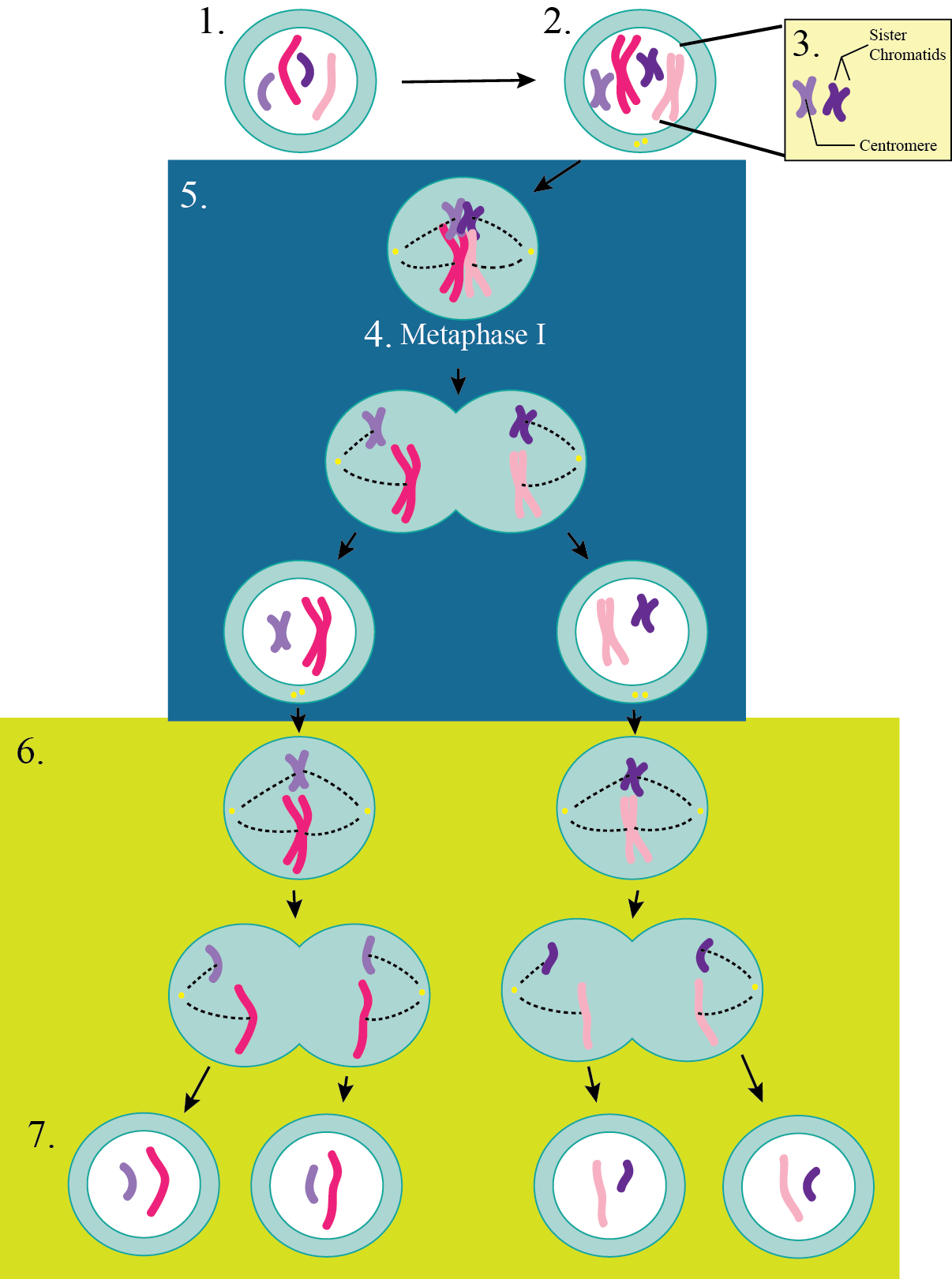
Question 1.21
8tV6sjOcsqDL7CV24SEgzYcuxew41Tr+LwE4vTB+ZWdU70AFwq9VOCGsAZBSWKpTbldZWuSra2k=The cell divides twice. Once during meiosis I and once during meiosis II.
Question 1.22
zzIIJ/QkgOGuDsKOv3dyvcozDNf0RUyL+0hWRAsbJsj+zQ7kjxnFSRVzLMWMAqSNTdKJOXArVcIuxaHIQQkcPi4n4s5myhJlD/s4plhN1Tty9LMbt2KkJpAVRH/TAzGrlFIifybwMC4OSy3+Kq74+TNMAsC11nARRGvfZUndf+I7+ZxcAlAJDkMqthCtAV6R7ZAQHHphS7WbcXSL2ewiRtC2KdmOSGkEGOxnxT64dqRAsz4qVXifUJd7H3b6R0w8RWiZM3X/7+xCRQnH7uks2w==One original cell with four chromosomes results in four daughter cells, each with two chromosomes. So, starting from one cell with four chromosomes, you end up with four cells with two chromosomes each.
Explain how recombination of sections of chromosomes contributes to the variation in the combination of chromosomes, genes, and alleles a child receives from their parents.
Question 1.23
VCM50AwNTvH6BhLyPpiVcwIx0QRmbnhlePMyhdHJOjVRaxquBcE/kHfUFTb5wtmDAC7rPeD4GpTkWu0wBS5Fp49xZ+EF4utiqo0sYADlJQ9uIpjIF2VtAuqXY2CbdB8rw8N9NNdWjON7/BF8G6ryaiMKhWEdY78LtCv6yCUWMyU=

Question 1.24
Xl/ol3nwDL2t16q+O/5C0NLQ+7FiaH8B4X8DFdVomGv/OJNwNNYFNapC6/IjAzA9zJNl0cHTuiO5sFtOI/iU2sgHVHYuofhvqzUprnv4VPXKBkLy8SrNzzMEkjoTbmJcNBp+R+YCly3sx773grRLiUfA1hitujes25DhWgVyy6BK7OV9LMJqZvp6b+pb0DT0VyXvzn/saYSPPpsU4Xmqt4/8LII=Question 1.25
/kzvnEWs0Ew3Pe6cQPF3uWMtmDcQzFBxS4Djb7PLsJsCr3IOOVh3Dnhykvz/wCvJaY1PMp4AwejtHVOBRkFcIFdNSi24NxbjtjMLXKloyukVsO2a0Q/pZBQ6UdSqr9iJmdzZQg==Explain how independent assortment of chromosomes contributes to the variation in the combination of chromosomes, genes, and alleles a child receives from their parents.
Question 1.26
Ir0zM755+95hS/oiLweCz4/1JwhpWA+f+oXaPVF0c+jlY3Tx4jgOy4U3XhB72jLCXYg4EDx1OBW6JWZPgnzLQ6EyuiIP5MjVJw2e50f5e9Bc0aMBgU9Vol4nAT4eP8TvwCsx1Z3IJgLnfjCiH1ANe/MfTLL5G/dL7l7y13ecu8FZ01H4CXrTNhtDLZ3a5klakLEjJIGSkB+jFU64cOjSubyOVCFP/Pp91qbgK2Ok9O+Y0WS8AlluFb23pqKHFxsDp6QiErTI04BfNaUN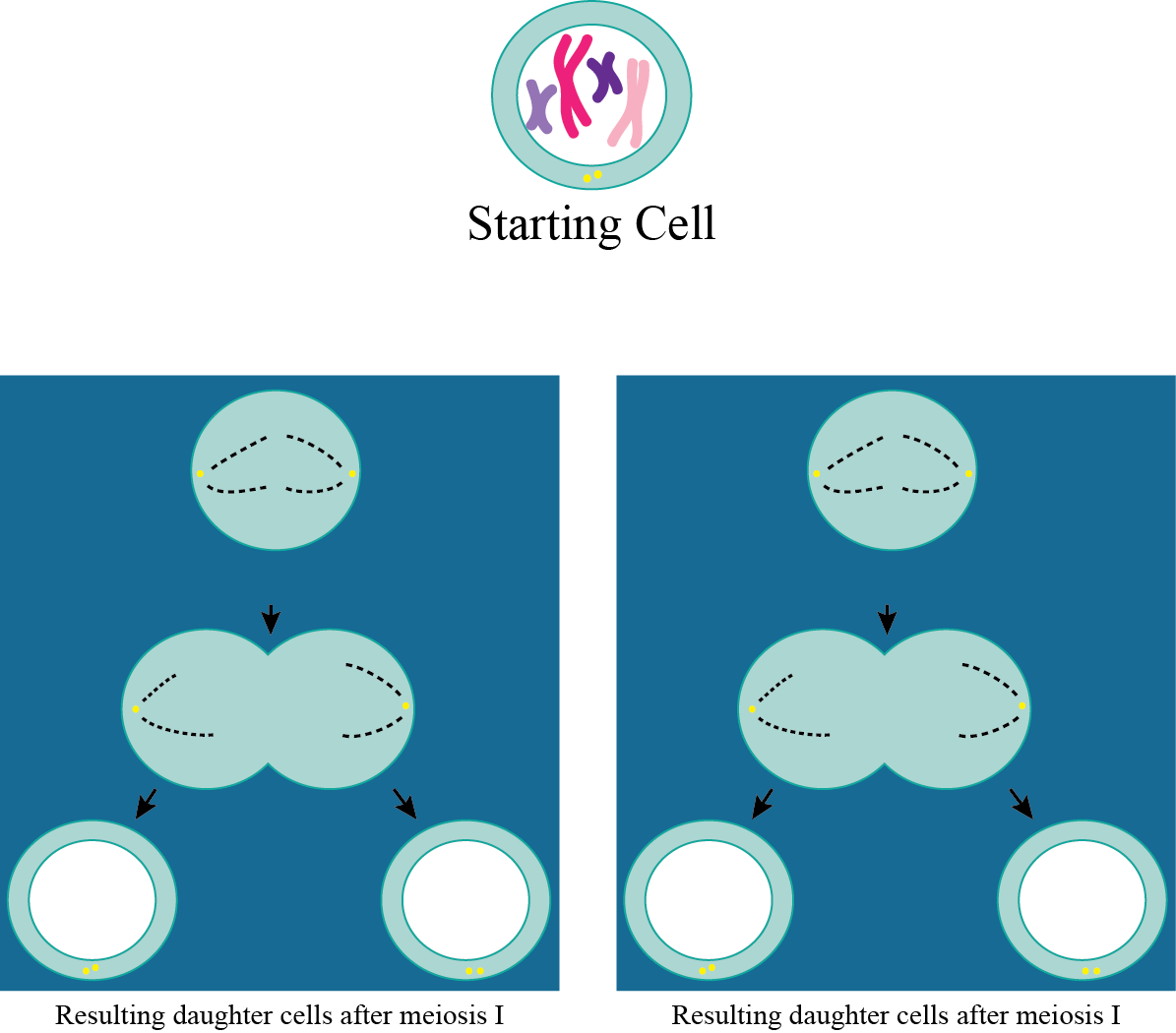
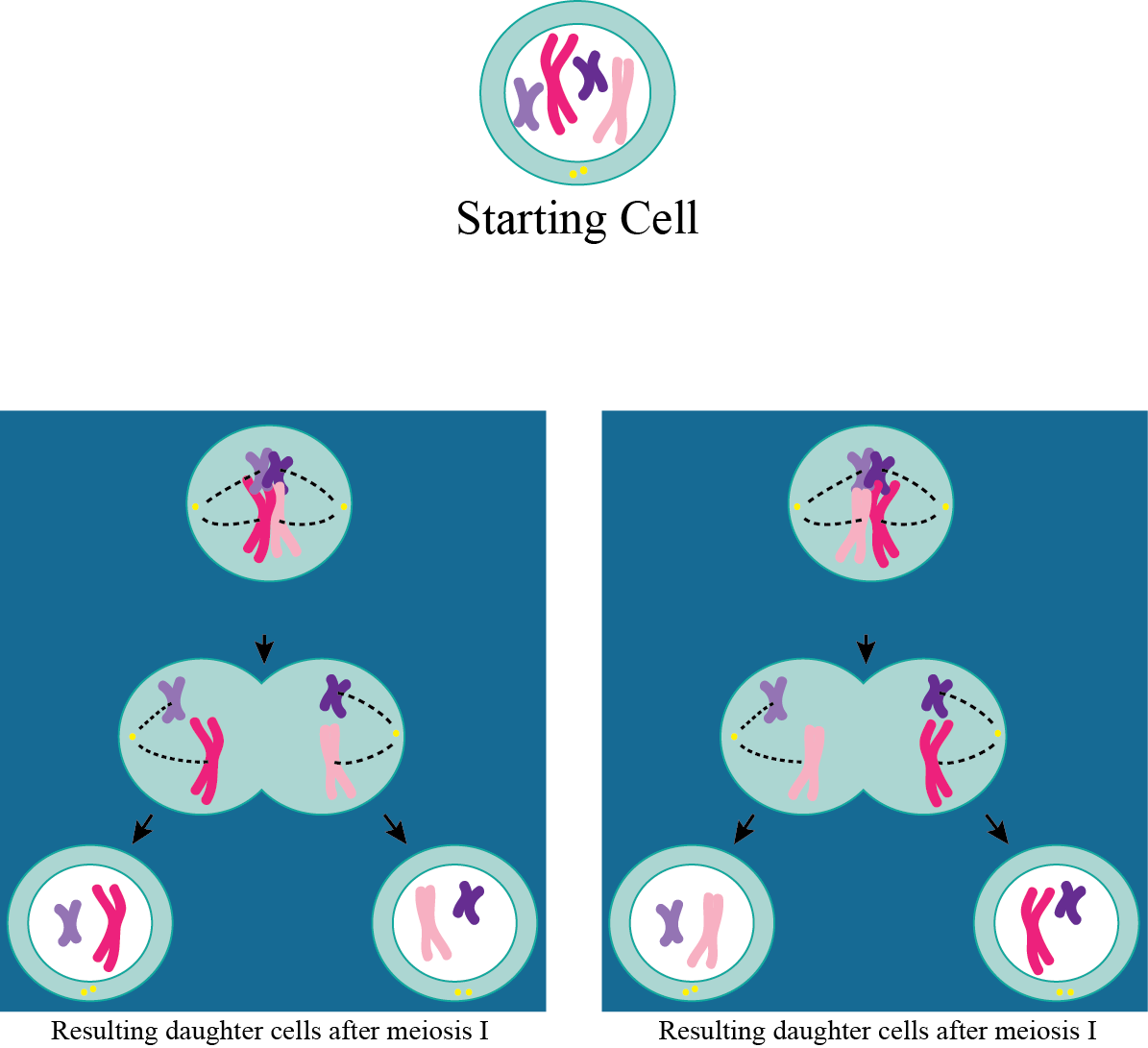
There are four different possible daughter cells, in terms of genetic content, because the process of independent assortment says that the order and configuration that homologous chromosomes line up in the dividing cell is completely random. So the end result of meiosis I will depend on how the chromosomes lined up in the first step.
Question 1.27
fJhkRqOSM8a7rj8eDQIBfyI9Y+hwVQfhaGAgLXHKKpMDSA9+eyX/7VtaRf6YV03VVHyL0PT34KsC8x7QcvLuqobmN0XaKdpe4rXXIEwD7xdB5xJFNX/OLg2mSyIlRlWL1+JHqAYZ4MCoJRYPBG0FVL2z/03nlX/hRuNJ0p9usvHhJPnbmanEqbptsxXAFTfYLkjkgrFjOnXDqAebtCH4KZjOga1PjWPS84tS6t1XOh7DYfcUK6metVWkfiEgyxpBGy6L41uFXK8FLtSyvpaN9HDOXSxeTzbM9IL/36nULJZ1Q4Wm0IeQnP4fvUCgSDEriAzqO5LMcLeJS7hs+mF/h14foBvCBrlJVxAqWQdPBNi4gAW/8YzFAgkl5dVtWeTshvo2rw==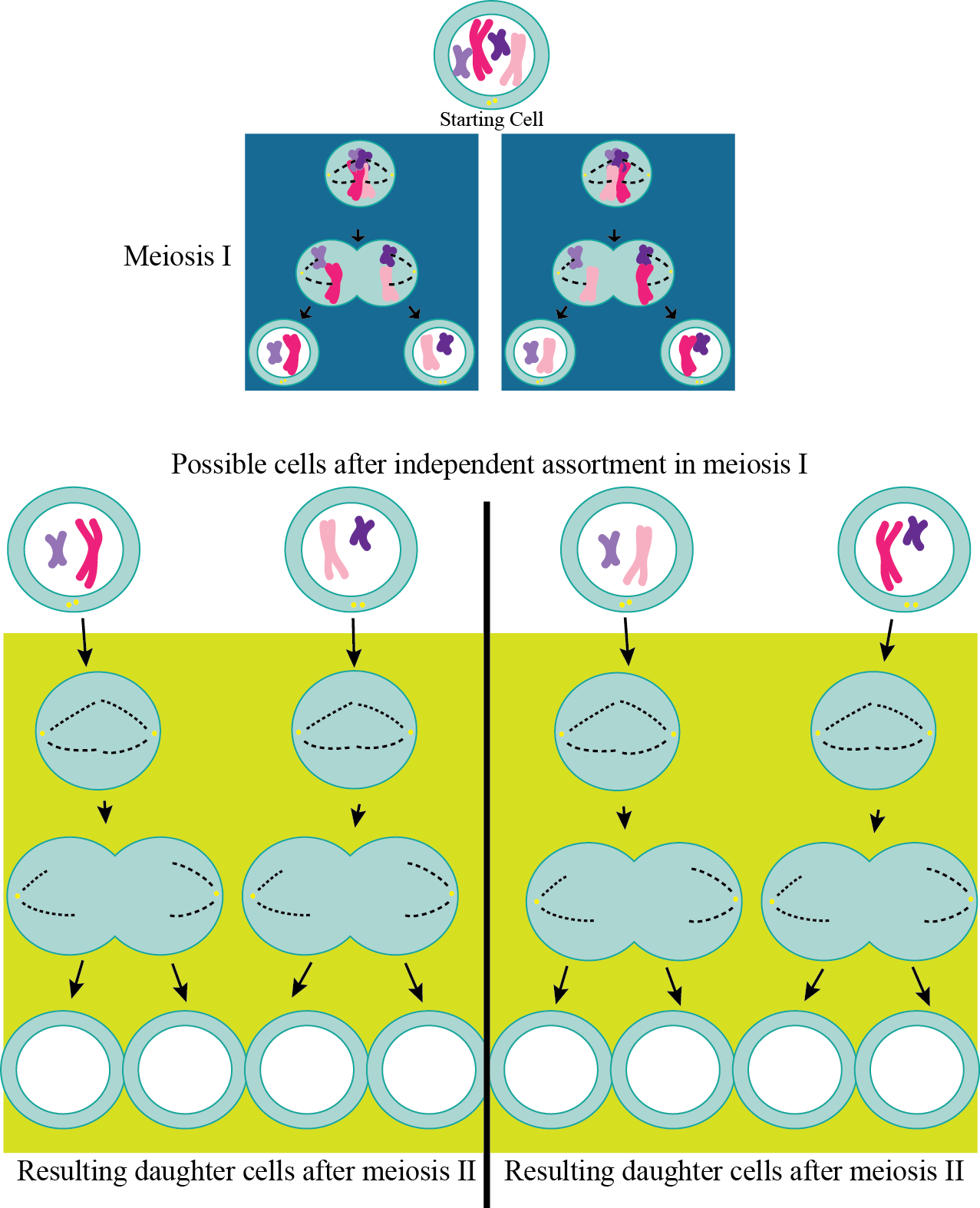
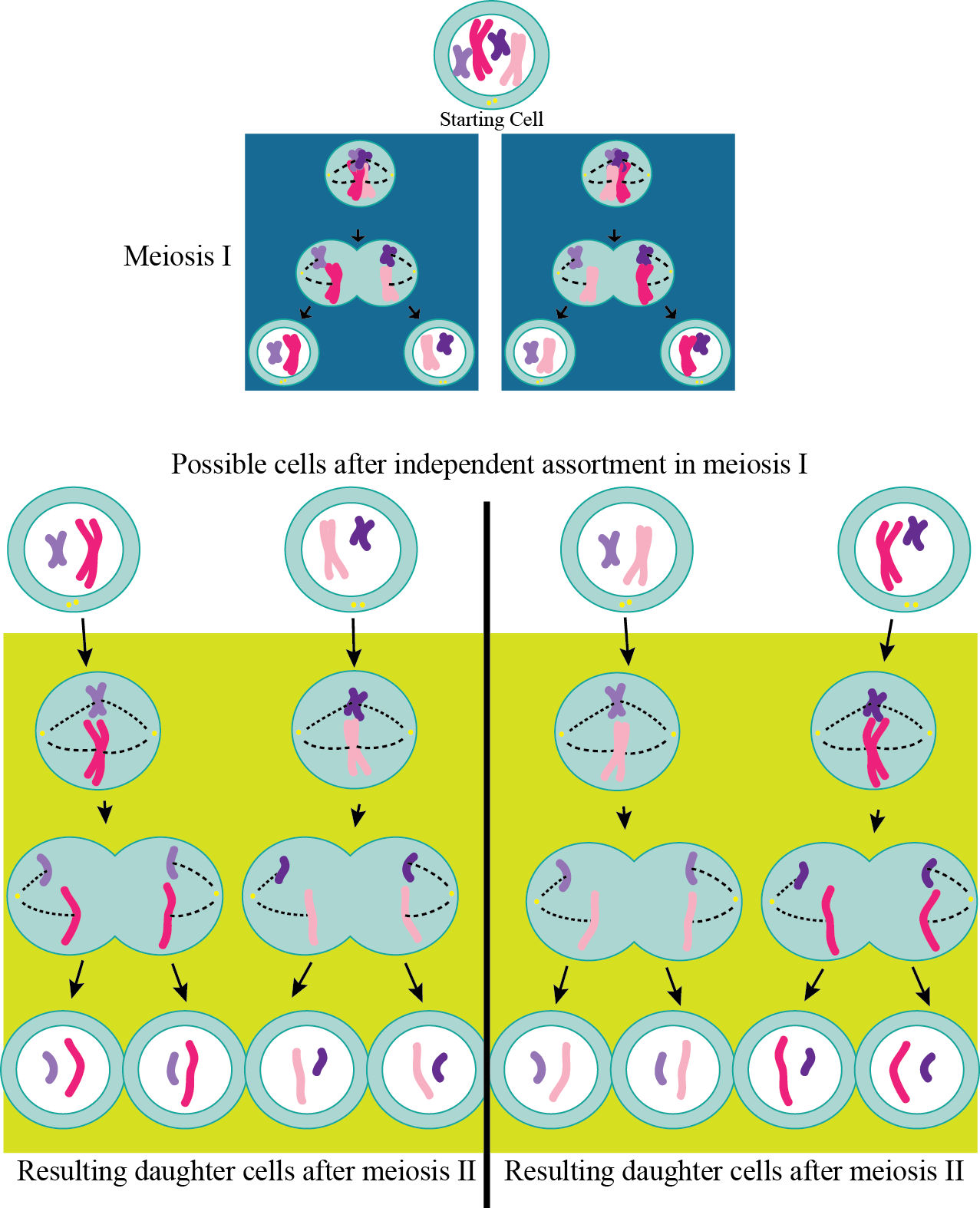
There are eight genetically different daughter cells that are possible because of the process of independent assortment. Once again, the order and configuration that chromosomes line up in the dividing cell is completely random. This time, however, it is sister chromatids separating and not homologous chromosomes.
Question 1.28
Ervz3oBht93mN/t4Axiqu8Uk9CaKUSk4dylmSxLYRyVXMBEqnyHLZLOxiZfoJEm3zntpZuHS0CNh7fr5EetptoVX0oxEmRVWF2Ivw9OVU2cqRSvFoTe+y6mmqDz/MVIv1/QFIbu2J4jdlHKIM8+s5unlzdRIK7Tg+2iqfiFNPq5j05rwyT7CGzSLI0W24ChWfh8jZY6jpSqkcfYZQuestion 1.29
iZq+1QIEKjwvGVxsr/gnTkYY+nzjmkb960rJYAuCTc5cOn/YWdnO9cba1JZbi9hiP01dqlESBJ8g3NjpjumNbyxiq3XG3hHDtVFPE9EFag8Xz/kUHc4AT9nIgOodlxjFiGoQ2DxB0V2NJKdlVs3wVIaN+Goy0Ojue4yMgtEytPYn+71SAyoNuAD2khr8ADnO40sIYRdTXqVlRBybCompare and contrast meiosis I and meiosis II.
Question 1.30
Hfm22h4tCbwtRVepSIvEwbMHz0V9XQfIc1lsa6vXzQPd+mgM5V4AZVgbvgcehSVbsWN0mojJXPVW+7zhcuffr+UnWyx3LfKTSiDaEx4S5XxjwTKEoi7bXN+EF48kFPO0EVe3fRTEAdt/JF4QsZwML6T/ogUW+n8ceMgaRvB6TdA3MPtWv65a13203C/8ODDaLiG0MMTmx6tNPgMnReview Questions
Question 1.31
uTKYBOGEetjKZzi8BZTnouoeHIOULyys6L5xt2FlL0kLpVLWrI6rnhn0XBQQvmpC/TzO03ZJAdklz375VPELvYuo7mjjc6vPzY4LOs12wyWS5eesR/UMPRLkkwWh3bnq7Zl1wdU4oOeRBmHDtXdlutUSB1n4xWkPRDhNk9QF1gtz0k+jAAeFrL9SFGE3cpGnzcD8TJ0sJFg8uHVFQZzXRiXNyudholvlgQQ+jrUEDcCwdsfOdoThOBhOSR5OHEOz9zPoZivarMdqzsoVOT/c6I7KPJQkSy7M++azsOTsAON0wTxkVsIL8e5vC/ZCb7IAQuestion 1.32
jR1gPeBU0cvzB7AXcEza+SkJU6XzPaOp5gV0EzdjxZRZ4v0/1NqcouCE/6Rvzlto1R0Pq2yE2vym0iP77BjU7+/xw+7d9Go4drUb2Jg2kELaUf4U+1qPII9C5QjBbQMmh+VrTtMmCiYjtNuGITssxASuy2Vc9ERWaMibcj/mj6krC3CeFzwvgu//MBz/YeFLN3sVQkSyLKVkk5xojXoKHf4zCWuHGQwH8MkQxg7CrA3wUEJTzCuI6pjECJ80qIR+lswGTFnJyzCcyG0WvuHl7ws3SCulsoOEjn7vnd61L/lWB/KtzeUqgkulJBwr3LtajrlaI7W96m4CAWvh/hPoBjPsJ0xir503r75FZSc/1ndpNY1/0Zo7N7CIteuoHOtqekl9GUC3B2PE/8DKIzPHN0SfHhqQ1QbK4PeQ5pjJQw0=Question 1.33
D1K/LZVwX8kIfypcKuAgvonroVP2Ya4gO0M6n7VIbsqbA121hVIEMmzwCfVt8QtFE1ZMjChYdossjugK8QsWhF4x1yq3Qdz9+7t5CfJeszq1TNBeVemdCkQN7K5Zg0i64TsXf/30m5Lgzgv89gXlnoZFvcYR6jfpy7PcB2bDZXvQ089saDEsKRIczpvksUyomhP2X0Y+66ij1RiONnA7Qztsg2q27ukHL3jR0reVlik=Question 1.34
Vlkcd5uxOiKRnp+bBhyJEdSMUwLwo8K5jN9PhsRHIkCkn80oWoX5FuMYiZNS4nCf20vRfokJ2Q7FI+Qs6d3kshV18LUZ8olT1DWNPWEXkGdvhW93icMEf1DroCvkORORF6ODkVb/SEx8B53skzXAyDq9VuKzzWvk6/y43NCyXZP4rTKxS5+iK46BHH8NyhHBotc5Ha6EV8IXD85Y5ShcR4DqTdPuFB5hd2tCIxmw1CvzR/R3qGawNxL5Jwy6Ebc2IIYEcQ==1.4 Driving Question 3:
Driving Question 3
Why do different traits have different inheritance patterns?
Why should you care?
Cystic fibrosis is considered a recessive trait. This means that Emily must have received a mutated CFTR allele from both of her parents in order to exhibit the disease. Either of her two healthy brothers may have one mutated CFTR allele themselves, but because it is a recessive trait, they do not have CF. It is important to understand how recessive traits are inherited; if both members of a couple are carriers of a recessive allele for a genetic disease, every time they have a child there is a 25% chance that s/he will be affected by the disease.
For any trait that has a recessive allele, there must also be a dominant allele. Emily Schaller does not have a copy of the dominant (and in this case, normal) CFTR allele; if she did, she would not have CF. Many human traits have dominant alleles, but we should not confuse dominance with prevalence. Some genetic diseases, such as Huntington's disease, are caused by a dominant allele, but the alleles are still uncommon in the population. (Another uncommon, dominant allele that is not involved with disease is the allele for widow's peak hairline.)
What should you know?
To fully answer this Driving Question, you should be able to:
- Calculate the different types of gametes a parent can produce based on the parent’s genotype for one gene.
- Differentiate between dominant and recessive traits (phenotypes) as well as dominant and recessive alleles.
- Predict the probability that a child will exhibit a recessive trait (phenotype) based on its parents’ genotypes.
- Predict the probability that a child will exhibit a dominant trait (phenotype) based on its parents’ genotypes.
- Propose an explanation for the reason that the CF allele described in this chapter is recessive.
Infographic Focus:
The infographics most pertinent to the Driving Question are 11.6, 11.7, and 11.8.
Question Test Your Vocabulary
Choose the correct term for each of the following definitions:
| Term | Definition |
|---|---|
| XUNx8L5fXDBmiloQn9tyi6l8nzTfA1gikxQQPk69Qeu+2k65N3aQYYL1Cuy5wDu6F9LS6Km7H2uhqqwTCUDlXCposZaRVVCxg3KG261pAmeUD00Zg3XmMrEQA5HXziUxFsEaMy9/92o= | Having two different alleles. |
| M5pWuu8XYtYaojzJJxPwdamwz9daYz01/Fmmz2L29U5TiK8pgqtbgSZy1/B8Mot83/tPmQRGjEO3dcofpQ99Lu752UbfZ6ICESUMBghNAqV5lqUMTT8c0dxFkXEKNdsA95OjqpyWvws= | An individual who is heterozygous for a particular gene of interest, and therefore can pass on the recessive allele without showing any of its effects. |
| dW3ttypFFDR4gj5ZcRhRxg4uFcQFp9UtJJDjoPvXR4U4WxcuST4sMh6I3DCyKiY+OPjs5ExhLGu/Pz5XFu9QJx4q6y/Z9AbQjBpm7CN0+Cb9QEPEM+EfonK/01BLjvp1cghm955RE1w= | An allele that reveals itself in the phenotype only if a masking dominant allele is not present. |
| Y8sKH0TfNCmbAw74rz+j/kNTITWHhy+bDZueHHWYcsNcvhVtzytvD5kNYe8a0CX2O58ltLt7WpfAXr1ax96pR5V28Iv24D2LV3nt6uABh5t+UFnGK1BAd7KD4/LSg2N2CJKGZqrmP9I= | The particular genetic makeup of an individual. |
| A41xV/oFj1BKuBbVDNTytdKcMsnuNCTtFjj57FrIfg2LQAoLmNJXcVxb1dxChjpMslSNrfgKcCp0dKdMphXNPD3cEmC7923mHA5S/Kejsz2WDhEWiw9mEActfr3TY3FVKT7I1u6THh4= | Having two identical alleles. |
| +nwtVolMU/iuZoTfcBAnO+88CEVVLINI656oC9K/AwyhjY+G0ePktIlbLxmIF29Xy9QbRUs6xZSg4XNkxO4w8NvG3Gie8uVOiRSEA+9y5W82thetmcTt/FET+xMOUXdqp6fPP1zGKJg= | An allele that can mask the presence of a recessive allele. |
| ECceV3GKFj5woxzG8ROy2NI57ae/CSqldYKDEssbn0AyNj3TfMbHbFX54/JItomhMMxFwJvGEb11mRsE8feN0UFCPXvhI8n4lg26rl6/dWbLtkuY/BdghXs+RVVIXK+bbYqREzr+O7M= | A diagram used to determine probabilities of offspring having particular genotypes given the genotypes of the parents. |
| IVbxx9NulynzU0iPWmbm3II/62vE2mP+of7kkGi63dMj7vJl47VlOkH3eSP3BX7PCZrJvaO1Y6HgHRye6rHCLWNEY+fx2KYBHU6L9GUFsbtfD1f18MFKEH8g1vKSV3+OLgvKZoffois= | The visible of measureable features of an individual. |
Calculate the different types of gametes a parent can produce based on the parent’s genotype for one gene.
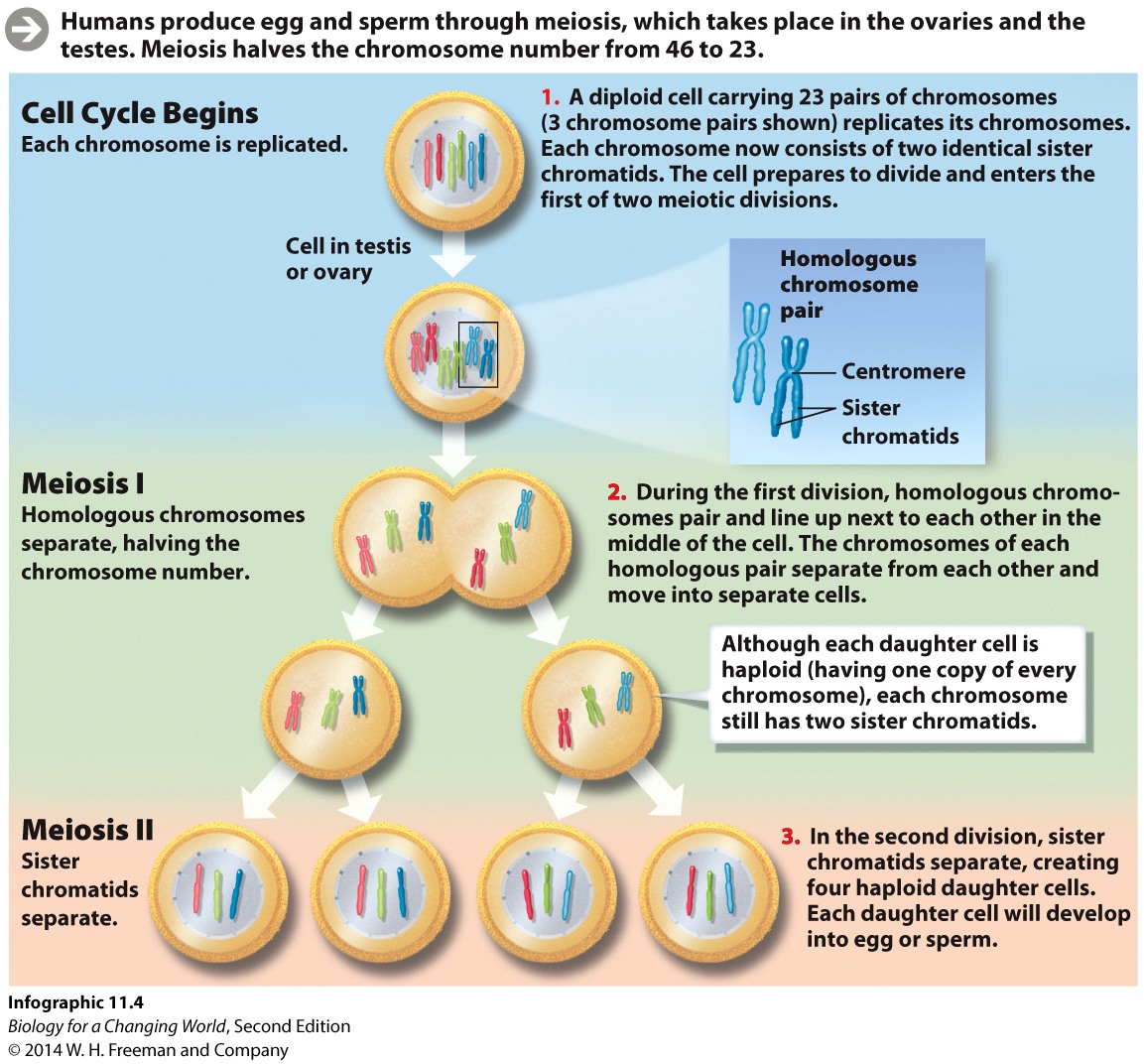
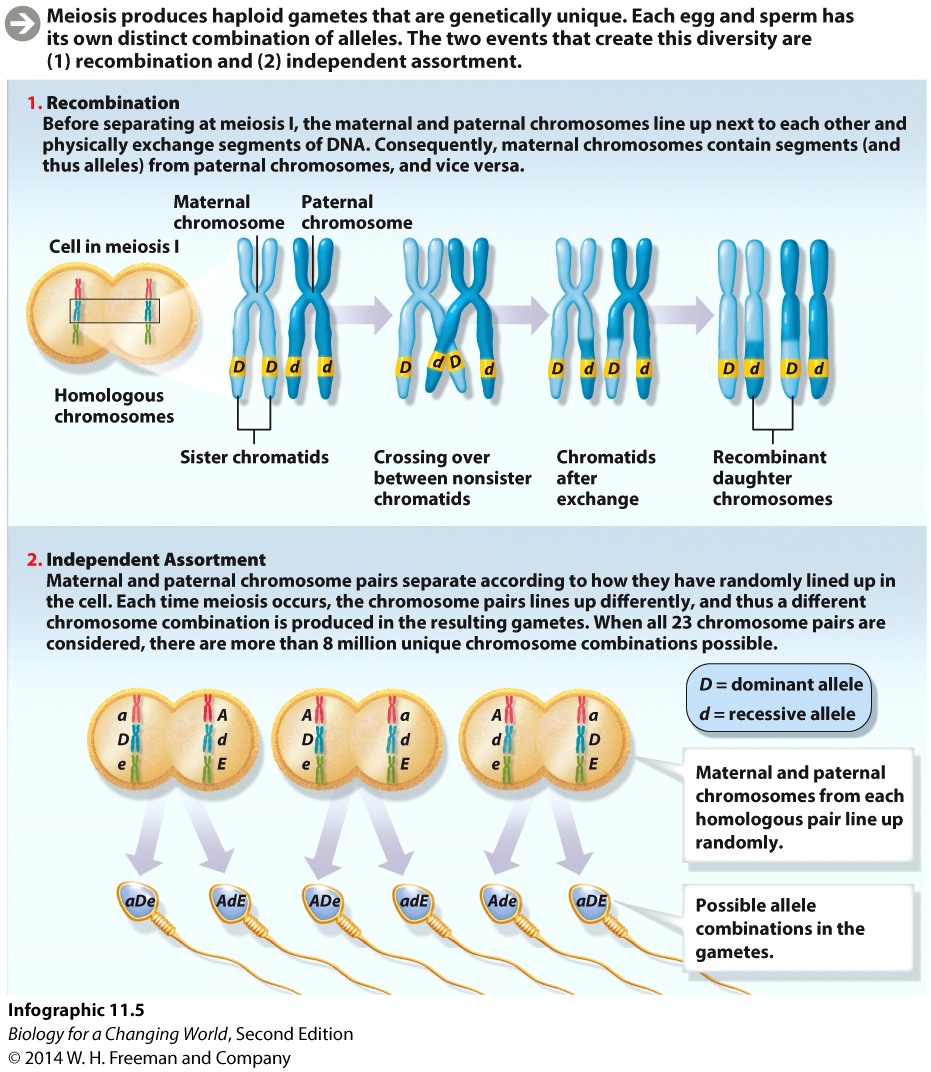
In Infographics 11.4 and 11.5, you followed the behavior of chromosomes as a diploid cell underwent meiosis to form haploid gametes. Use the knowledge you gained there to answer the following questions.
Question 1.35
aQL2hm1kG+0I3FqRt6Pswjuq6Z8Ip9rGz3u3vHzD4KuKdqe5TkvDE2ze9ngJ3gX8xa4qqulkOenQnmhMQmyvf8+PagMvYKyesR750oAggw5hoxQmakhO05efNlLkx3H7zymVfpB67TncRkByzV/jLLHJ80smvy2RH6xMoW14n3bYNLBrxXN/qx126ZYERG6ZwPAvR1TOB6+v3SDyesSLTxyh8Be3/BKrV+QdT+u4N26hZlWRf7eh1DeOqrAblgOvnHuyjfobd37e09jlfv6c3s7DftrSEYZhOPq2VF4CCJA1/e7FJyBMcP+hpzQncq9yiQ1vKGHAvQNe980/Zs1vo0a56iyn8Eh9GrhF7TBv2wTIjKGLTG7SAT+tWdPebBcYHzLVWqDlzxpTVVwgtLJifNlhqg9XUuSRp4BYSrLGJt6H7f1OZ5PAmwm1cF0YAigzxPc39/tQyeLQvNZYqnUmGRORDqNflGbgYiE2P/vkUJPtcfWAXZsKP2azIO85LjjrM5TW1b3h5a7qT4N2Zs+RP1x1AXJvpCP6CdaBR8Gv3qMC/EIj4a519G62f2JSTO3HBILTLCgfDbuALikNaZoJp3pYfpoNziNqpgxiBUHkRtBh6KtI/NrFRTcoAyk/xPEUYEX0KkqqdoL46S5jJOb/fDtjgFVj++M88YWZbiLZsnrkPBq+7hGGtxTkatt2a/6HPor+95adrgH+BQlpuVSZaQl4YE0qjy0F5DfOT9WK24aP7z3N7IoaUl/RVT/OkVVu0xDc/SESNp8oSB5worlBKt2YFRjyhDRh8IQjsXulVex0l3RNnZ5rWtpuaSVFWtovHfzoZ/F1e3D78eZCiDRpYJEWIqZgZu++NqTUy+06E6BI7bbRd8f4CRj+LNKLkSlAFaMgPA==Differentiate between dominant and recessive traits (phenotypes) as well as dominant and recessive alleles.
Question 1.36
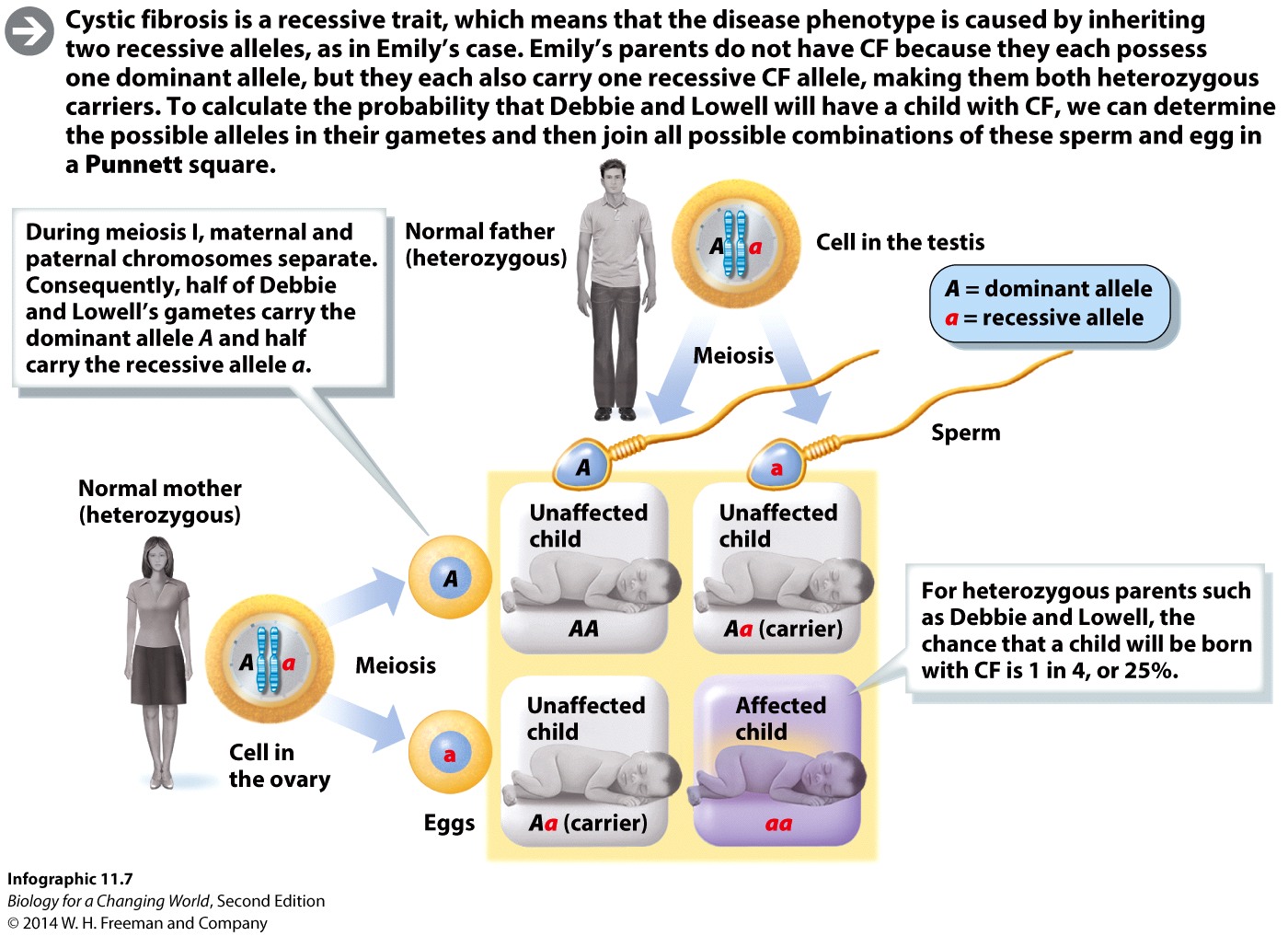
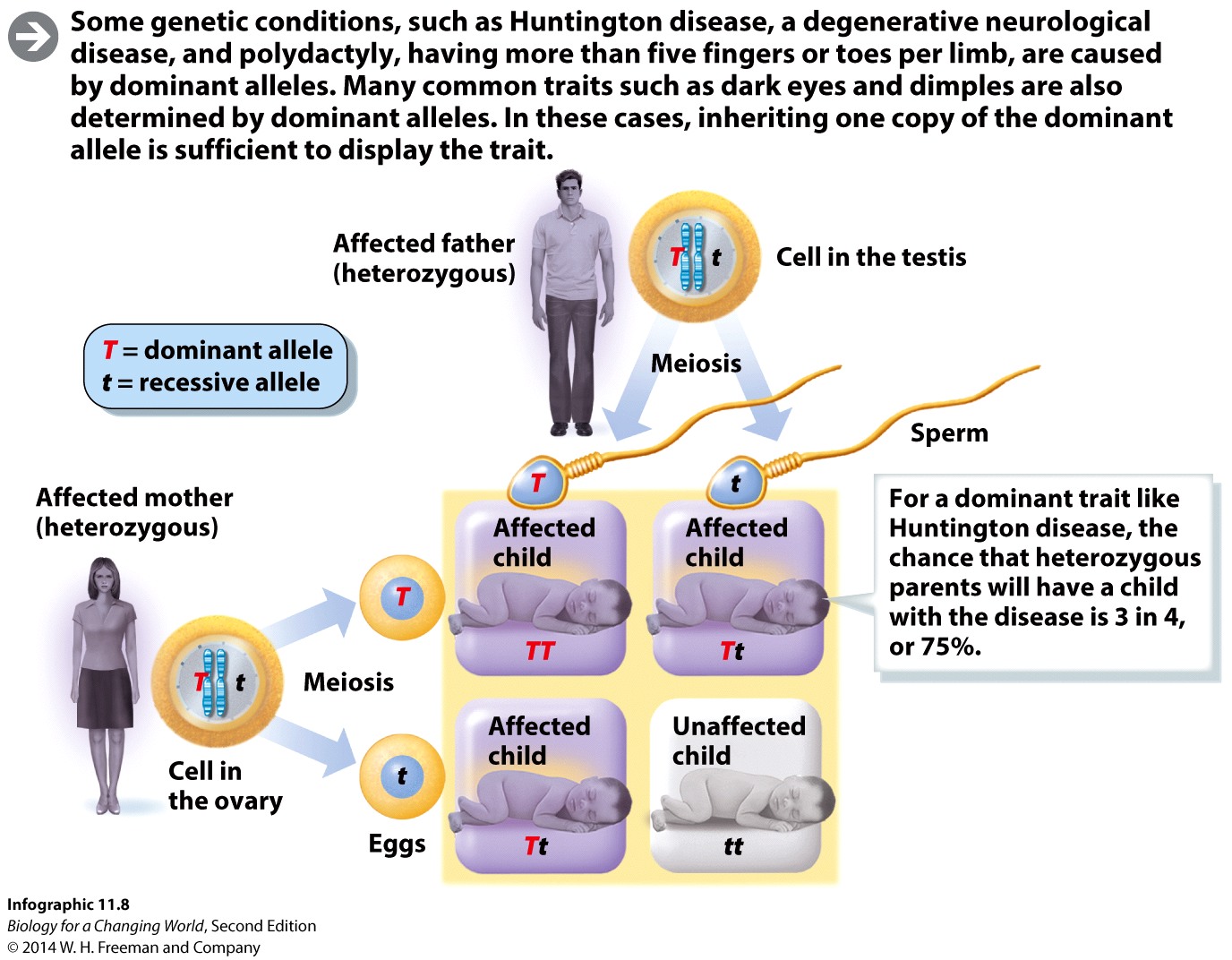
Examine the Punnett squares shown in Infographics 11.7 and 11.8 in your textbook and fill in this table:
| Cystic fibrosis: Consider the case of two parents who are carriers for CF. Let A be the normal CFTR allele and a be the defective CFTR allele that causes CF, which means that the normal allele (A) is dominant. | Huntington's disease: Consider the case of two parents who are heterozygous for Huntington's disease. Let T be the Huntington's defective allele and t be the normal allele, which means that the defective allele (T) is dominant. | ||
|---|---|---|---|
| What is the chance a child born of these parents will have genotype AA? | Bqf/EtUReUc=% | What is the chance a child born of these parents will have genotype TT? | Bqf/EtUReUc=% |
| What is the chance a child born of these parents will have genotype Aa? | fwIPnBkWdu4=% | What is the chance a child born of these parents will have genotype Tt? | fwIPnBkWdu4=% |
| What is the chance a child born of these parents will have genotype aa? | Bqf/EtUReUc=% | What is the chance a child born of these parents will have genotype tt? | Bqf/EtUReUc=% |
| What is the chance a child born of these parents will have CF?? | Bqf/EtUReUc=% | What is the chance a child born of these parents will have Huntington's? | XqPzZf5H/p4=% |
| What is the chance a child born of these parents will be unaffected by CF? | XqPzZf5H/p4=% | What is the chance a child born of these parents will be unaffected by Huntington’s? | Bqf/EtUReUc=% |
| What is the chance a child born of these parents will be a carrier of CF? | fwIPnBkWdu4=% | What is the chance a child born of these parents will be a carrier of Huntington’s? | gzSKVBDrvH01RmKU |
Predict the probability that a child will exhibit a recessive trait (phenotype) based on its parents’ genotypes.
Because Emily’s parents are both carriers of a recessive CF allele (genotype Aa, i.e., heterozygous), there was a 75% probability that any of their children would not be affected with CF and a 25% probability any child would have CF.
Consider a different scenario now: If one parent is a CF carrier (genotype Aa) and the other parent has CF (genotype aa):
| A | a | |
| a | Aa | aa |
| a | Aa | aa |
Question 1.37
RHGsuzD7irGfPzP5FwVQ2uPxVczA81O7VNaKvq9pmTtgxAVA+B5vqRdsE1K4tLQBNFC54sBwbmIu1r/FvEJDIgJ+ZpnaL5gIyVGECjFt6wO+V2uP9RG5rJc01YEHbwbBV+CP+HRH47k6WasP5K9uScukZux2natPAwyKs8Sq1pq4wbH3pBRuaqEt5fL1V8Aw+Wg8Pbqx7cyJ94P7I6ScEQ==Question 1.38
NJekjuZcycaJkTZsrtXR69b6fPr7Ui9bR+raS4UVSR0Z8O0C1HS9cYWFcOqvaxUHTCqXz0uh/rcW0t4D29ym269rtyMHIfdmAEprLRtd/eMnaMgfhEYyRjkXaJaAW/7ZylcztlJbFWN05g55d9Fr5M+pIC4=Predict the probability that a child will exhibit a dominant trait (phenotype) based on its parents’ genotypes.

Examine Infographic 11.8, illustrating the inheritance of Huntington's disease, caused by a dominant allele (T). In this example, both parents are heterozygous (Tt), and so there is a 75% probability that any of their children would have Huntington's and a 25% probability any child would not have the disease.
Consider the situation where one parent is homozygous dominant (TT) and the other parent is homozygous recessive (tt).
| T | T | |
| t | Tt | Tt |
| t | Tt | Tt |
Question 1.39
Ax/EvH1UIDzVShURmWj5i2ImWyUz2jqV/jhi0Ae8fmaRGwFaZ2DKkKp9p9q7e/ckfJscDzqA10oqhvW6CfY1lluMuYzAqJuYAuT+qv4SGp/7ldz19SSj+LvoofmDZd4mWdpgpg==Question 1.40
U6UhaVyTkN32oERavT8olPjtNZHRc8fGBmOJ6dyQcnpXLXpZaznf53lYttflMbtucn7H7Wk2aby8IA5B/VOIUPelsWZBGFHiyTyP3w==Propose an explanation for the reason that the CF allele described in this chapter is recessive.
Question 1.41
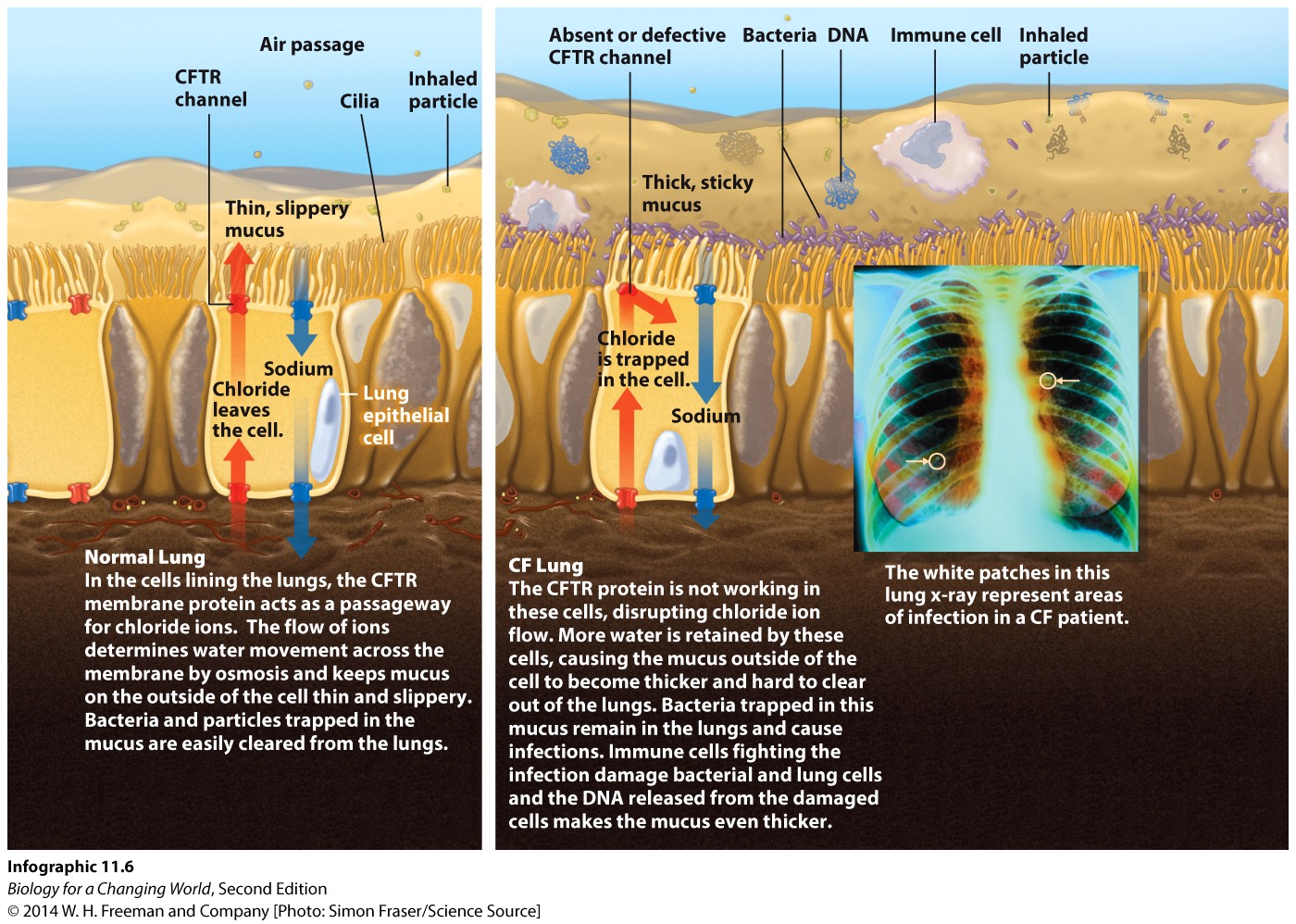
Review Questions
You have a friend whose brother has CF. However, she and her parents do not show any symptoms of CF. Your friend wants to know if she could be a carrier of the CF gene and, if so, what chance she has to pass it on to her children. How would you help her answer her questions?
Question 1.42
YDuOxtIG9OjdD8a+VnGe9X7P1oLa2K6aRVOVVBG+VMxUC9vZ0PNWVOjvdiWpqf39uQgTLQ==Being a carrier of the CF gene would mean that your genotype would be Aa. You would be heterozygous for the CF trait.
Question 1.43
NaklZ+3aTfjWjFMAoAb5cMambkiGftLPMwEgCdqF83Uiz+M/k/plE8rTkBmvOx5CdXc25rhngHFApU9mxnLeSQBk/yA4zzcosSfwxeKWRh5f2ph9R93u1rt0L1qZD2iNPBtaEcujpqxWfzxCVBppR2sD2pTwlgU2pvIrvg==Since her parents do not show signs of CF but do have a child with CF, their genotypes must be heterozygous for the trait (Aa).
There is a 50% chance your friend is a carrier.
| A | a | |
| A | AA | Aa |
| a | Aa | aa |
Question 1.44
6QQgw99+6jQm4DzHoz/6EXkjJ9O6ZR0IxeA9NcqXKAnP6fygUAmNg/jTdnbRWqhhV4dggf0w5zANZhU43vYWA0XQ25fjyORWgTX8t/WiiZ21KKrtPvZY2PiQQfOW2qs2pOsoF7v5ZG9o6bFaKWgTR2+vELs=Question 1.45
For the next set of questions, assume the genotype for her mate is homozygous dominant (AA) for the CF trait.
9AQsaAegcEdMkrA9rXbspWWhxL+3UtB9CcSAEDGHab7HdYOni5InfssrDeKFaE3401ZxE/VGc8nca9qetaROU3+L7oeFIGblTXXcxG32wXUFfKPTrAFkm0TV3WC0Oa99WsdgmOmo3S0fKA1GSJ7b3bR7LJBwo03MYCD6Y+X8EuE=| A | a | |
| A | AA | Aa |
| A | AA | Aa |
In this case, there would be a 0% chance they would have a child with CF.
Question 1.46
d0TAo6kPiSrfj0Goqk9WD9W34cw2kCyG+jt0rJmFUkM=I would advise my friend and her future mate to consider getting a genetic test done to sequence their CF genes to determine the probability of producing a child with the disease.
Question 1.47
EjfcT4hMmdzPvkr08Uk6SBBWLSrVCLEH8RbTl1aBn+E/DhW5jHCJJHOozdZRM7OoaLRbsGHZLSJCDnVGr58BhMD0IG5k9zw1NHvyve+mA860FUzMoUSgWnNnjW7W4CRy6QTR5XFUB4xdek8mbgWYlaLQ9YzmCa9mHwhlnB6ZOGRA93d0aIPLUR5McPqYVcpdtXfrsA83f0HgSnHCjqv3H3JTG8hwlAqpCrzT9x9Eci+3FXAwkkMB760YkCDyyCx555MIUNhYrL16WD3ZCmkOWSXmA18Wn0EgDjTAs3sa/nNZc6kpgC8cGbmhUvcU4zCHfCE0KA7nRhG/IXn124rrEPxudpyOjbAbJVR5nDQc14A7kUvPY+8WJMZNHO0+To9rlV7L/Apr+MboKvanlgL+mQFjUQbV6Aw7ZSdp4wmNlyNxHq5/RglP4fZMM4l/qGe4lOkPo0KB4ihrw+AesTCQrrGUSn5i3RHta/z1YmI17ynNc4GQSince the woman has Huntington’s and it is a dominant trait, she is either Tt or TT.
If woman was Tt:
| T | t | |
| t | Tt | tt |
| t | Tt | tt |
If woman was TT:
| T | T | |
| t | Tt | Tt |
| t | Tt | T t |
Question 1.48
Vkex7dOFd8+jjMsYBLI1d7ZZOI8jpt8fLHZDnb1YBDibsWFUtna8ARz4qQtHtKnsEV4tMOPl6+DN1ounYSikEwcI/UOhr3fWU6dcUkazLvHSmgThEkwY/x6krvy1Pf7cIGlsJFcC21kGoKHZVMm2rKKZQ0GlRlZWMt2G8q8mU+Y0lgfdP+1VKRFPJS87yJXJcC9HKCjb5Pclw8bmGtXdVJDpcdNWCOWh8ghGTghLyEhTNgH9GVOTwIeCFmwDeN9CAfNHPmWa3FsSI8UdgxFAb+kQfXEfItWbLiKc4GgWzQsdeEyJa7T+82yMH4OhUPdxp3BWLZMzMk7itweRAhE/IorKZA3WtPvwUoKvluY4Al65RbQ6tKjn9GRBIhvOq3p8NVaevQyE0+79yc3OHZ6pFB04FZ1KnxnBoOxjCROslY/DAb4KIjHpqJIKUDw0TlnWH9rEl4iaRZ2iuKk+1OX6WSqRZNgw9UIdybmibAzxETWyBFxjcYudj0tJvrZrMjLSrtkJFIDdYmjeFdIVhQMdX7tq0HhZG+d21dvyV0yajB4XwXjttzijjk3uoqvI8WCIq+Uw9PEqm7JH5GZHalhhPcbrJuvJbXh8+e6B8ww5YCe8spaGhBTiNLX9dei4h7E2ultvP5k+nDs=If her father cannot roll his tongue, he must be rr, since the trait is recessive. Since she CAN roll her tongue, her mother must have had the genotype of RR or Rr. Based on the Punnent squares below, you can see that the woman must have the genotype Rr if she can roll her tongue.
| R | R | |
| r | Rr | Rr |
| r | Rr | Rr |
| R | r | |
| r | Rr | rr |
| r | Rr | r r |
1.5 Driving Question 4:
Driving Question 4
What are some practical applications of understanding the genetic basis of human disease?
Why should you care?
Few traits are truly the result of any one gene. Usually, multiple genes influence different traits. For example, many people are often curious about predicting the eye color of children based on their parents. Eye color is actually controlled by many different genes that control different aspects of pigment production—so many that it is nearly impossible to predict the color of a child's eyes. Many cases are however a little less complicated, such as the influence of the TGß1 gene on the severity of cystic fibrosis. If you are able to predict the inheritance of two genes like the CF and TGß1 genes, you will have a much deeper understanding of how human traits are inherited in general.
The ability to sequence one’s genes has aided many people in decisions regarding their health. For example, a woman who has a mutation in her BRCA II gene, which as been linked to the onset of cancer, may choose to undergo preventative surgery to remove the tissue that would likely develop cancer from the mutated gene. The ability to treat their patients on a genome level, gives doctors and patients additional information they can use to make informed decisions about their own specific healthcare.
What should you know?
To fully answer this Driving Question, you should be able to:
- Determine the different types of gametes a parent can produce based on the parent’s genotype for two genes.
- Predict the probability of a child receiving a particular genotype after determining the child’s parents’ genotypes for two genes that are located in separate chromosomes.
- With respect to the TGβ1 gene, calculate the probability that a child will inherit a more severe form of CF, assuming that the two genes are located on different chromosomes.
Infographic Focus:
The infographics most pertinent to the Driving Question are 11.5, 11.7, 11.8, 11.9, and table 11.1.
Question Test Your Vocabulary
Choose the correct term for each of the following definitions:
| Term | Definition |
|---|---|
| QVYAIqmru9+eJYCqpGO9c/niVQHsMw0fJVQ9n+BZIWbUFnVzm+lijvV/1jzwdTrhcyc/7isqT04we9B+8/5Dkoo1GFvfRU3JzQgfL7sLi6fp59E3+HrgiA== | A diagram used to determine probabilities of offspring having particular genotypes given the genotypes of the parents. |
| Aby0wxyPVFtPH4d8u32ebvtnqsNgbXHbAr20lVcIAr6iL5FJyqljM2VwGvkYLSaLhn2/wZB0d7/CarDt+oXqIue0tCP3LTeuiNl1xVdbT5BdUHJzEAb6Tw== | Having two identical alleles. |
| Dv8N7dwE4YHdDwmegU8drNY/fPnikWBcBNDYHpBMxHgl1R10xrPh1kbRS7vzdwHb4aHzCqHJ56NoMFDWNUDEhsbErjM8wqK9oLP9M2yZewoTAxESiPsuNw== | An allele that reveals itself in the phenotype only if a masking dominant allele is not present. |
| QchHBXOn4Brjw6AIHwfUOv0fTO+K/KbafEOrC58p32xafYWDtddTlJGIOU8nX7zy6grb7Uk+VzcXplbKhJu4SpKpu4Qn9pM8yI+i0RzuGg6Cq2mzCiCdJg== | Having two different alleles. |
| M9hWeCBhPOSl7jYPNRkTzz12jJ+sOC34C96mEdqbXulzIfsovvGetLcbqZ4mcJXW6ESf2NnxF85O4MPMgvnOC8iR81NyrwrJqYlsvmgPLwSkEO4yLfc8MQ== | An allele that can mask the presence of a recessive allele. |
Determine the different types of gametes a parent can produce based on the parent’s genotype for two genes.
Refer back to Driving Question 2, question #1 when you took a cell through meiosis. In the answer diagram, imagine that the dark pink chromosome has gene A, the light pink chromosome has gene a, the dark purple chromosome has gene F and the light purple chromosome has gene f. You would say the genotype of the cell (for these two genes) would be AaFf.
Question 1.49
RUtMtWuhG2RzOwD/XmTpP50xdAH68THNkqgcQ3v2AP5+Qh+dpQcRqm70lrej0cNjEpKJKRdfe2M7mGo7d6ofOtXJ2j5OvCZERnmQvWktzBI7oAGv3rj94JqUQb48JMJqs2ISj5U3vP32Rn/dLGVvEYGlAmLmLhDqO7b9zh+ThmfHDB+hgSfdYg3osEA=Question 1.50
o0r/kNNsPnfkzuUrMDdhRqqYNA4SF/2D63mi0MEUWkWE7XgUdnKqnnjsIH3B0dd2J1h9cskS27F0Bt+opqdKri/gPZk25t7BhowwN/wUrIXwishSIlctCm8R7TgTPk/h2p1H6wKXnoY/xD9y1ND8Hg==Predict the probability of a child receiving a particular genotype after determining the child’s parents’ genotypes for two genes that are located in separate chromosomes.
Consider the following scenario: A man without freckles (freckles are a dominant trait, determined by the dominant allele F) is a carrier of cystic fibrosis (recall that CF is a recessive trait, determined by the recessive allele a) and mates with a woman whose genotype is heterozygous for freckles and is also a carrier of CF. Assume the two genes in question are in different chromosomes, and therefore assort independently.
Question 1.51
Complete the following Punnett square to generate the offspring probabilities from this couple, by entering the genotypes of the parents, the gametes, and the offspring for the two traits described above.
| Father’s genotype ffAa | |||||
|---|---|---|---|---|---|
| Sperm: FfAAl8H07x2VWOk= | Sperm: FfAaFE1JL6MGt+A= | Sperm: FfAAl8H07x2VWOk= | Sperm: FfAaFE1JL6MGt+A= | ||
| Mother's genotype FfAa | Egg: FAPTwMewEpDjE= | FfAAG8zLJ8A0ges= | FfAavf/LIk2EkK0= | FfAAG8zLJ8A0ges= | FfAavf/LIk2EkK0= |
| Egg: fAl8H07x2VWOk= | ffAABjhdQA12vGI= | ffAalYM2sFgaexY= | ffAABjhdQA12vGI= | ffAalYM2sFgaexY= | |
| Egg: Fad9GgkxrG7wI= | FfAavf/LIk2EkK0= | FfaahectwN2XCVM= | FfAavf/LIk2EkK0= | FfaahectwN2XCVM= | |
| Egg: faFE1JL6MGt+A= | ffAalYM2sFgaexY= | ffaa5pFjcovmwZ0= | ffAalYM2sFgaexY= | ffaa5pFjcovmwZ0= | |
Question 1.52
sXDQKoy9K+RsvDC0w/F7gTTezko8xVNSqdL0n+q+Xry+ebDacT3pKZh9E1BgL0T4KnusenWhjByUJ+PUhYgvGsrgh5IjOBq3oG0vbw==Question 1.53
ptItpRZ3nefelQ6P0fCxI/MXzmNMhZJpnIpOReHRpCrknYt5R6QfApnUi7VJdYaZGd503R40JQzbsSNz1emAOf+NTxQ=Question 1.54
3eYHN69YLPeHqlkdgjGze9QNQz12IUQZak4gnzx7fhernG8SfxxIXWF1b59ZeEWCp7zGJ3GbpzOv68fa6W5V0Xm1FT0rDW6uX5oBFnjFw6YYbNslQuestion 1.55
Mh/bHRDWAWM8q/1F6ukBle/0lI3vn0tkf4ZGTb8FTNbWtYNnIE7vO7/becqTzub4AeSMv0M8nIpz89wllE8e1sfAvCd8snJgrPg+2zCNrEMNRlADlwkxx9Ec0b1b35ggdEcffFqpUbKtkTG8RP8533AfdZzEATlLokbZjHfnbU9KDCyyBRzOSpP1tsGqteLvAKi2dwYrNAtDSKXQdX2TCFLvl8VtgNHiKrx/+XIXT2keyz2yYKjUX9zFg5LaZErTucOFvyrN/bbz8rde4qBMkJCvczs=Question 1.56
IKXRNEtX6i/bjwH9kJvEo1NNNPVIaclD1qDWV/nsiBF//phfL2hTLeCfE/t4h6dTRNpBjLchDvsUMMhC23jhIlfFUB43AVSoxF0ocKnWh+47rGqc+Ps11SjMCagGwJ0g/sHKcVDQ+9kt9HoHClc1LDazn625+8wyaUUKKqe4YMKCN6qgeHpQvKIfn5dFB7wawzmFZUS2qfZY5/N7A1jvRugSMb3smaHB+fsi2WLwdu/6DnzKEDzIj+QMyHAlezrqRpNoijtzpyuiyRL8With respect to the TGβ1 gene, calculate the probability that a child will inherit a more severe form of CF, assuming that the two genes are located on different chromosomes.
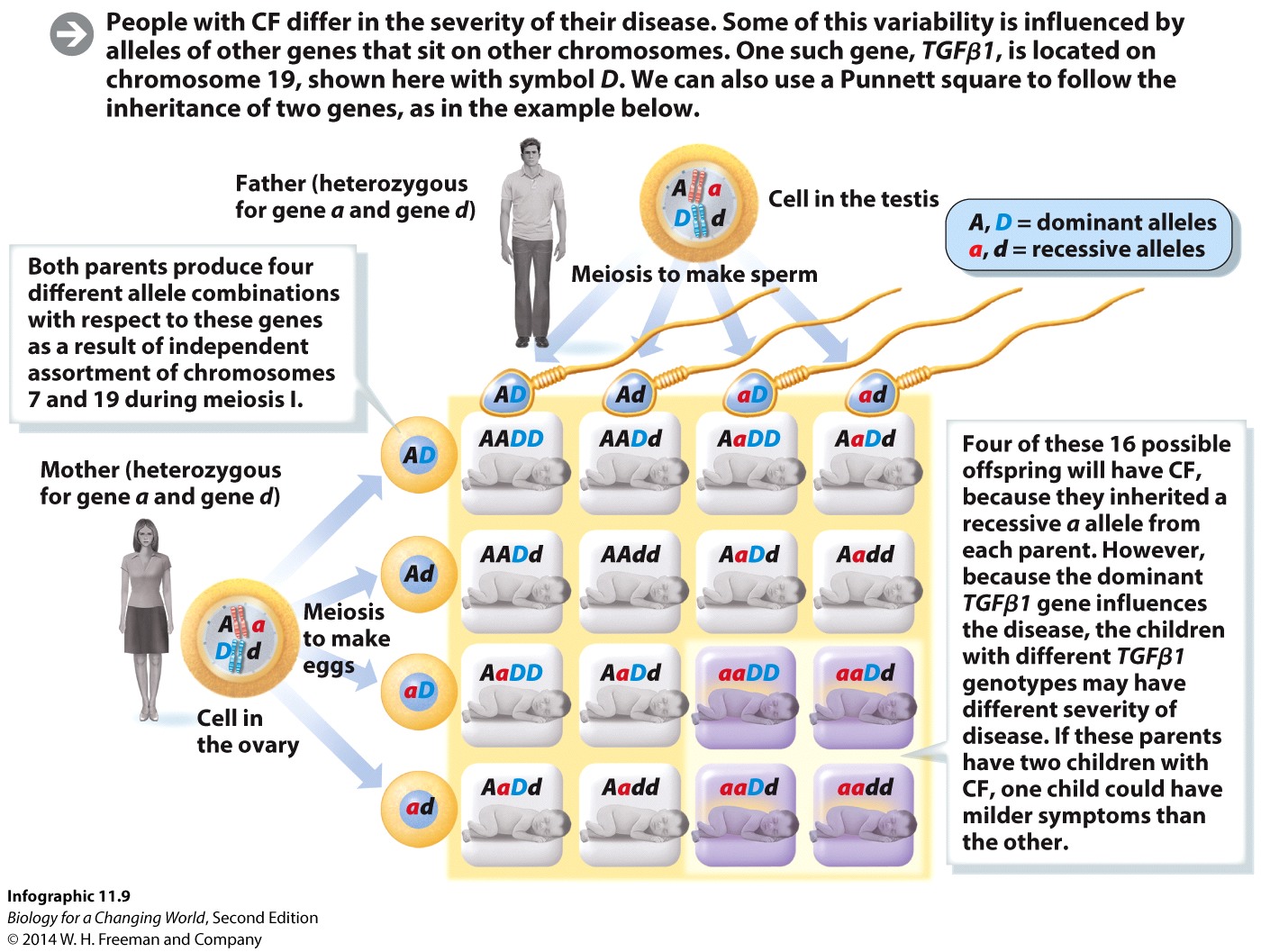
Use Infographic 11.9 to answer the following questions regarding the offspring from two parents that are heterozygous for both CF (genotype Aa) and the TGFβ1 (genotype Dd) genes. (*Remember that the dominant allele of TGFβ1 (D) causes the more severe form of CF.)
Question 1.57
5Q0orjVCTuKeOOM3D3Qaziiqp85yTzYOkr6r15Oq45PLjIT0JIwiXrAz4MloFN+l8qicAxc/gtzbDGd/mIP1vHVcIMlzAdemQuestion 1.58
RSdkcjTWgIyaMenUBXJNLSj04H6dh8CS+5iZtxUSh4sxrmzLR3B7xiC1Dcf/c4sZtfxW22RZaMSgMraM8bhDYKu9KZ8dV5PVttIghQ==Question 1.59
c7kdLxZJOQquvR3hJdBvyjh3ZMg0vBKx+uJHJxc+MJNV7lfk7rf1Y7MG53/8LLaz823Rm2n2EEDDNFInJESQUM/EcJnE5KDV9whm6w==Review Questions
Having a chin dimple is a dominant trait determined by the D allele; people homozygous for the recessive d allele do not have a cleft or dimpled chin. The ability to roll one’s tongue is a dominant trait determined by the R allele; people homozygous for the recessive r allele cannot roll their tongue. These two genes are located in different chromosomes.
For the next three questions, consider the following scenario: A man and a woman who can roll their tongues and have dimpled chins know that they are both heterozygous for each trait. They plan to have a child.